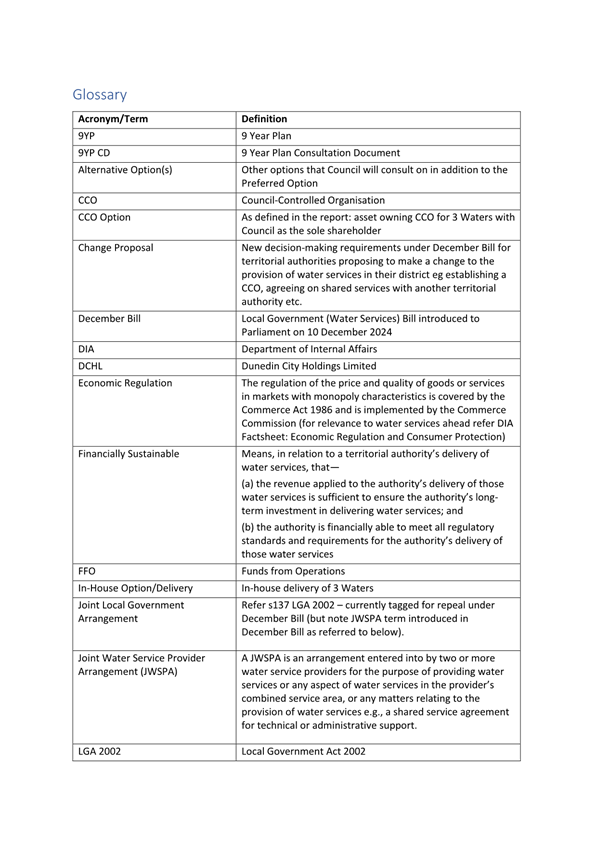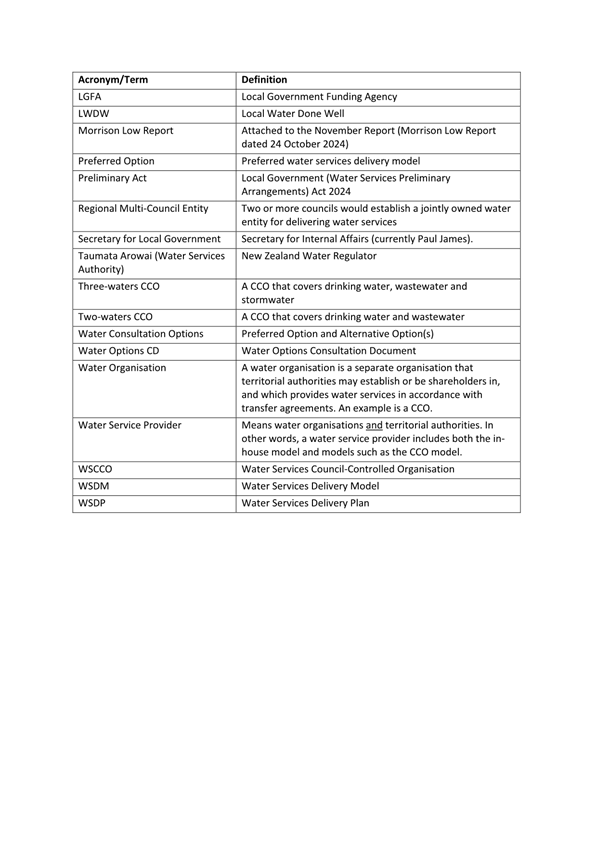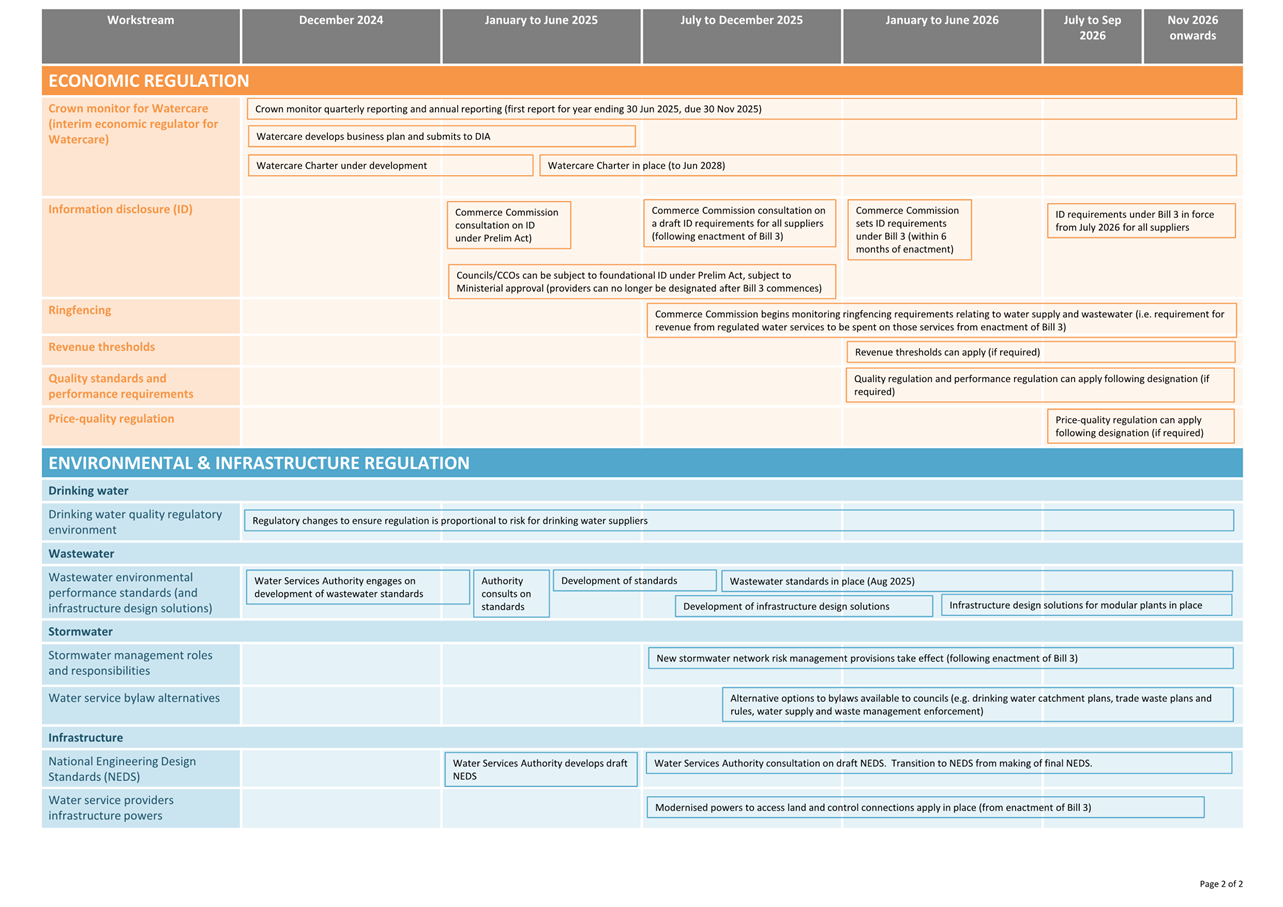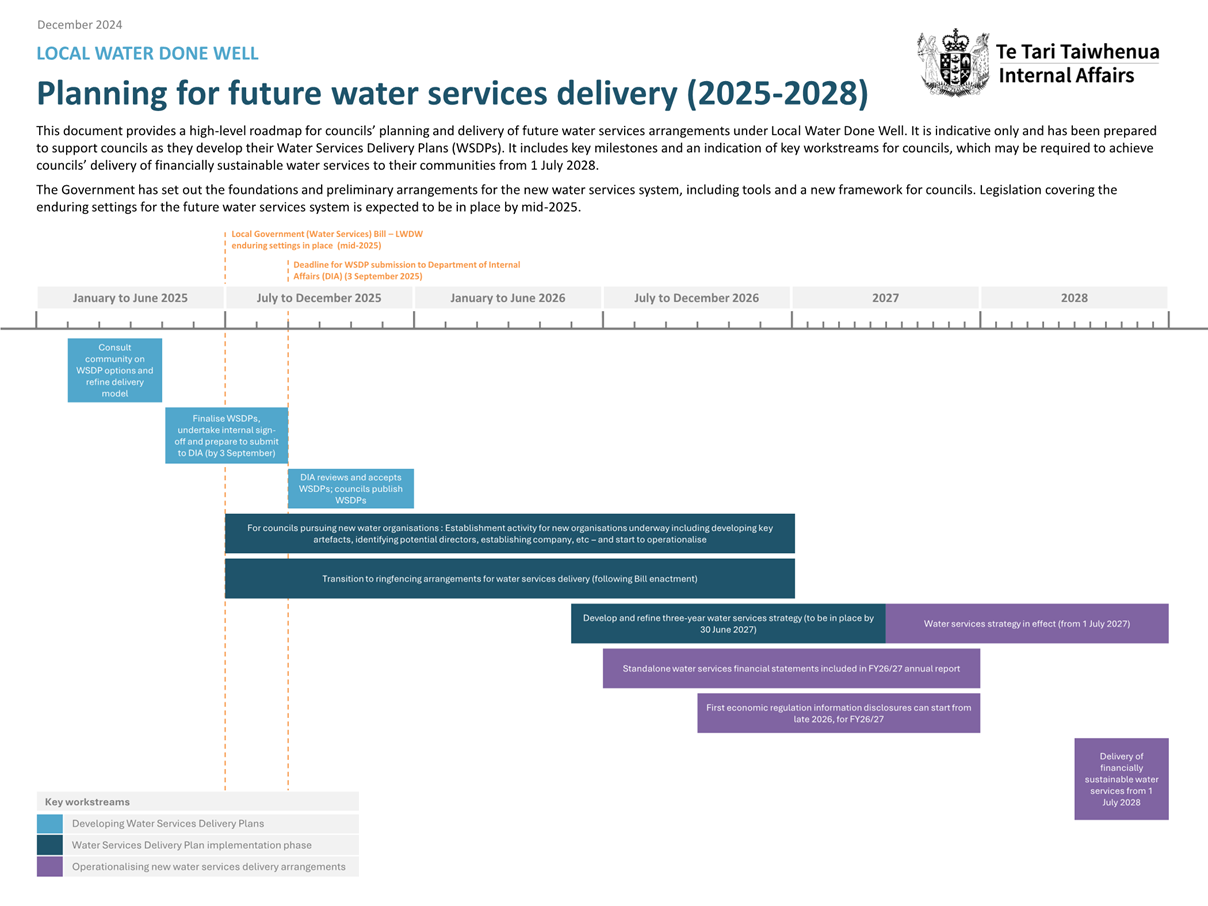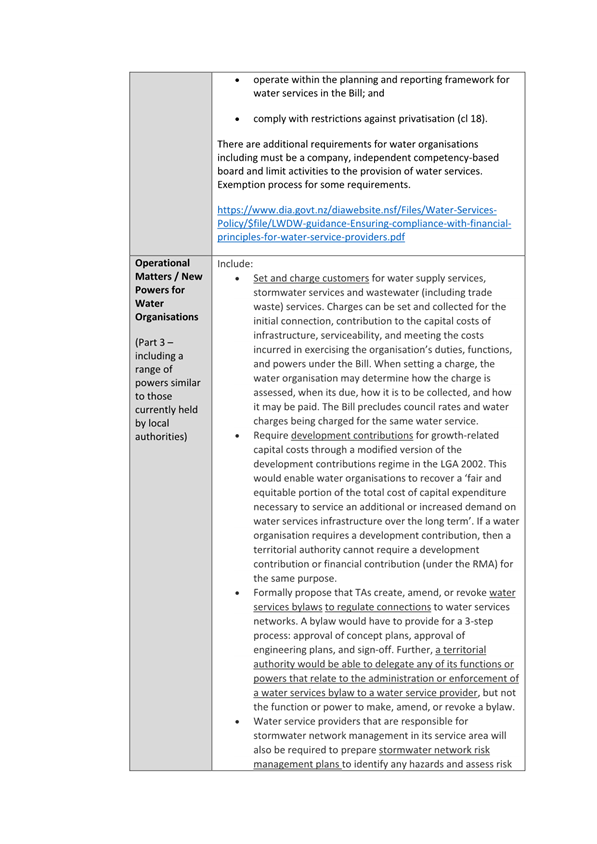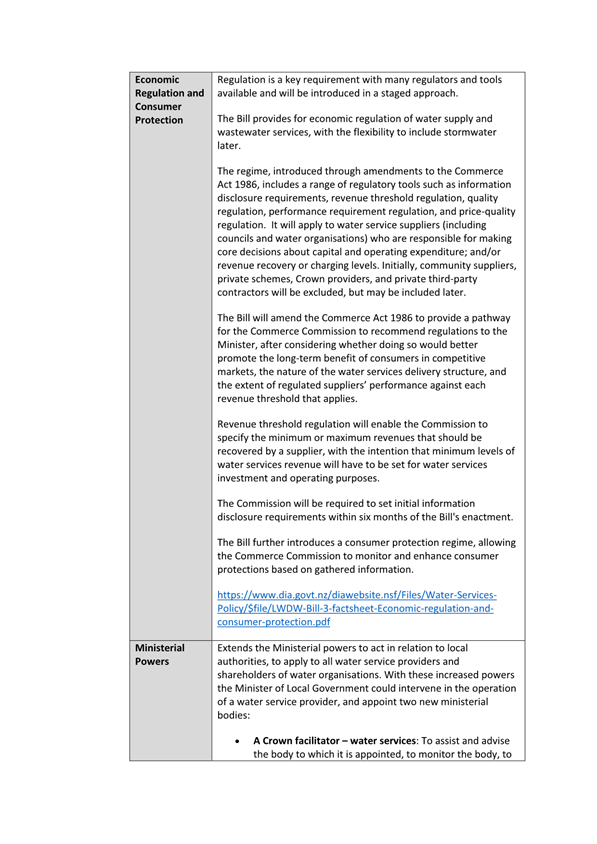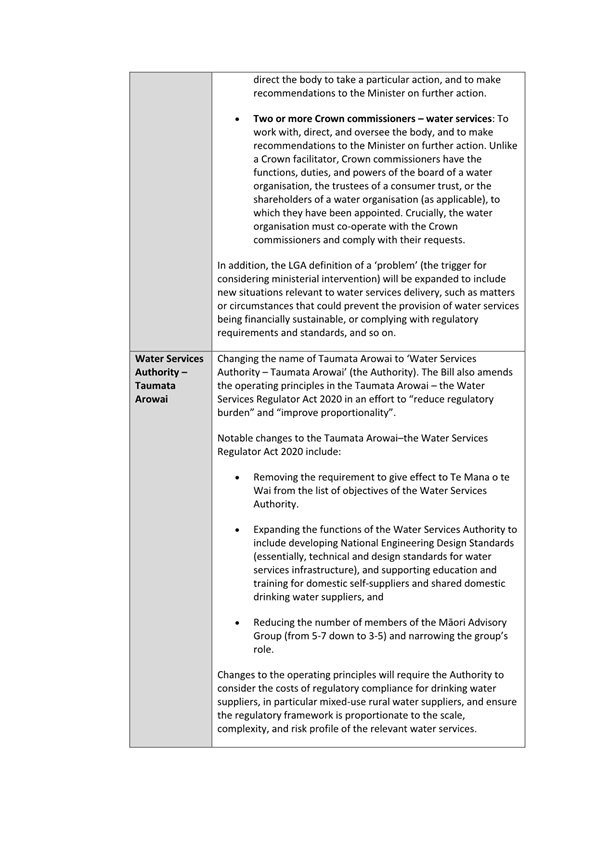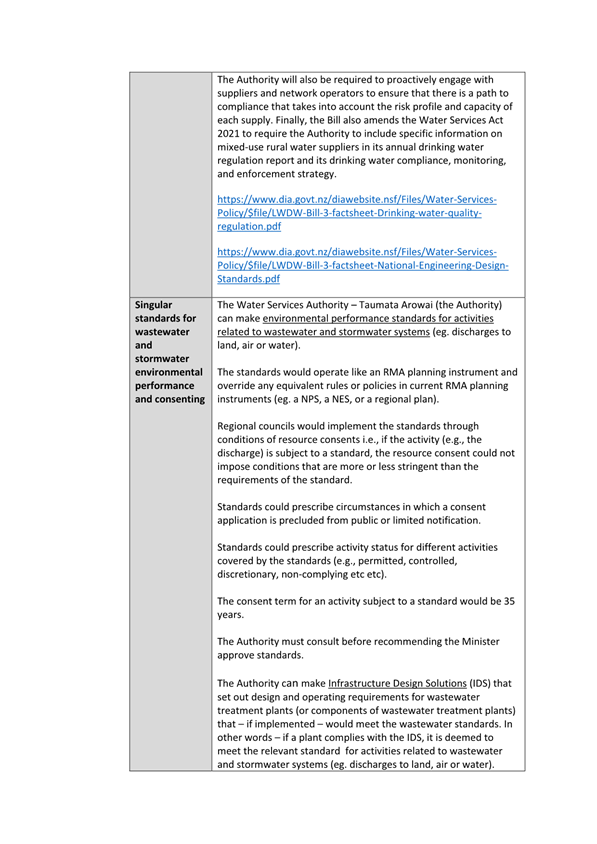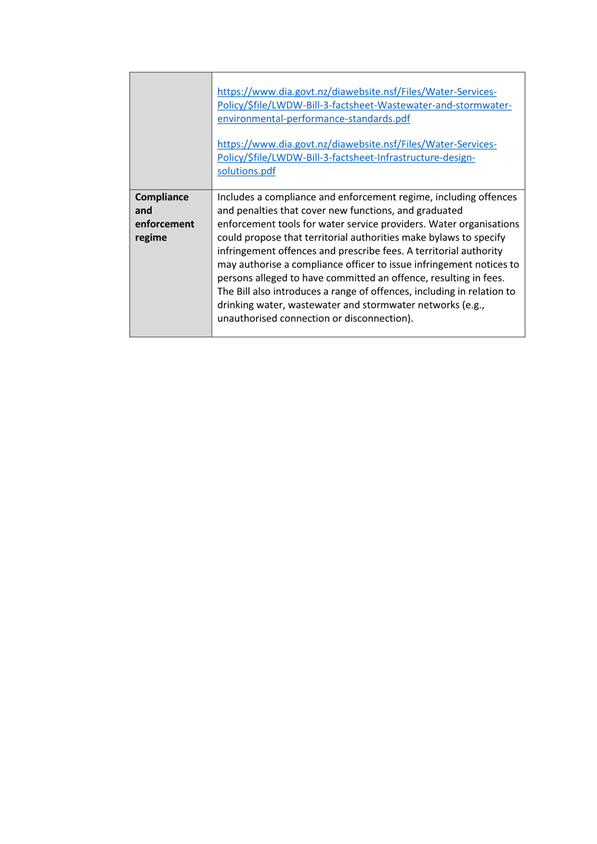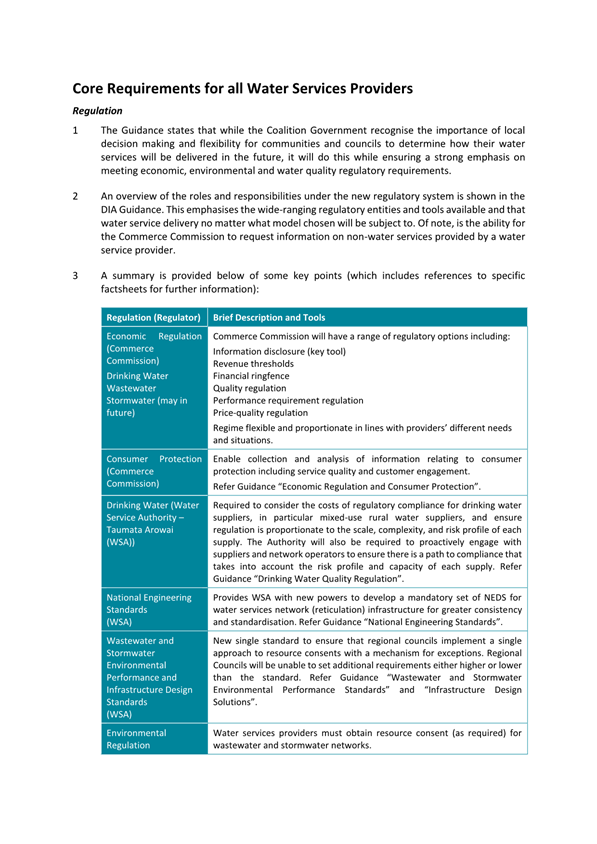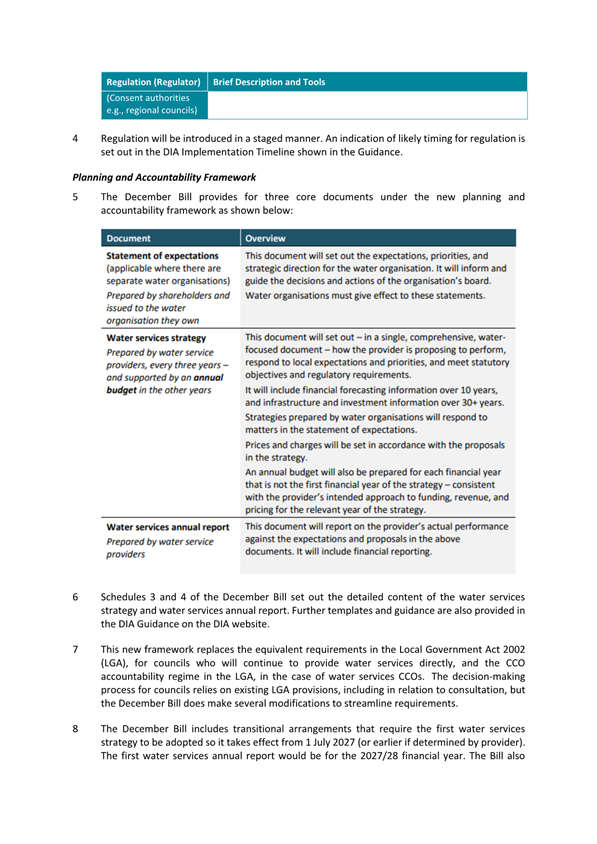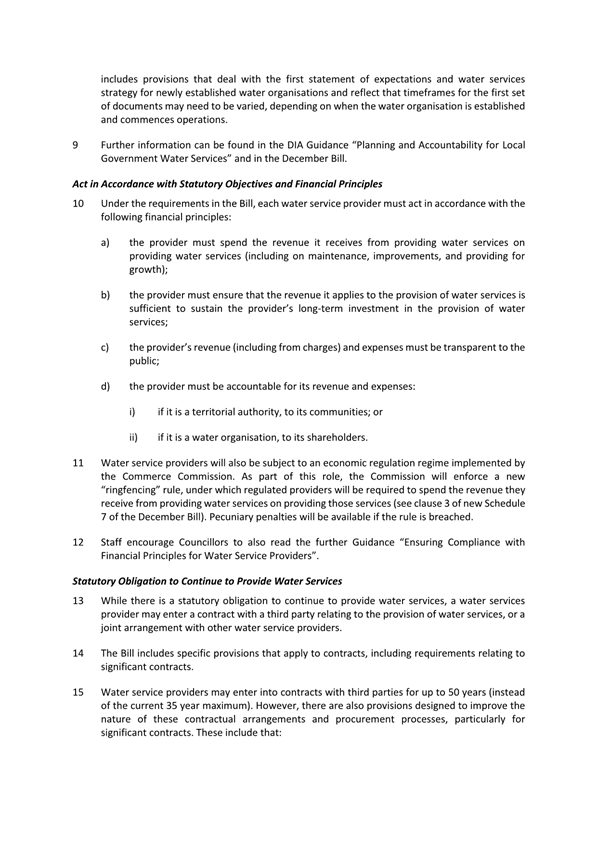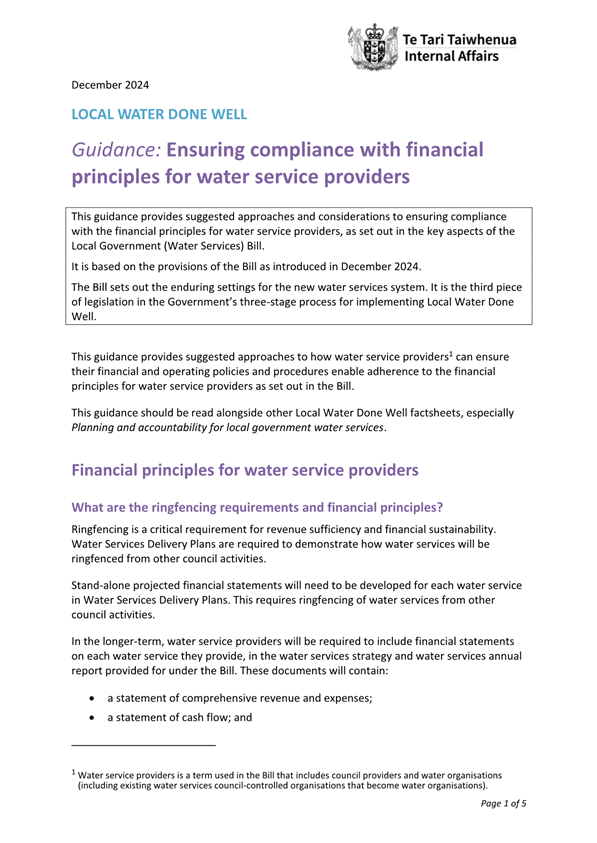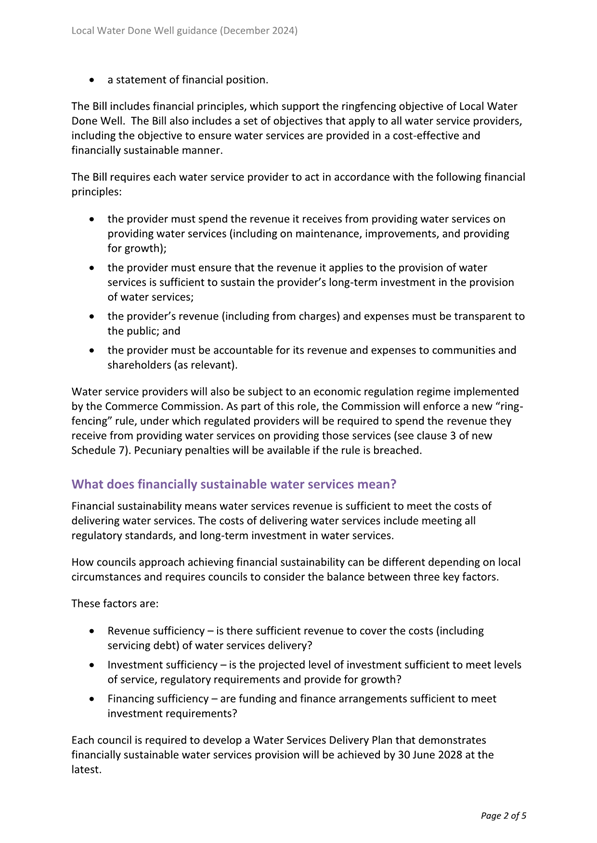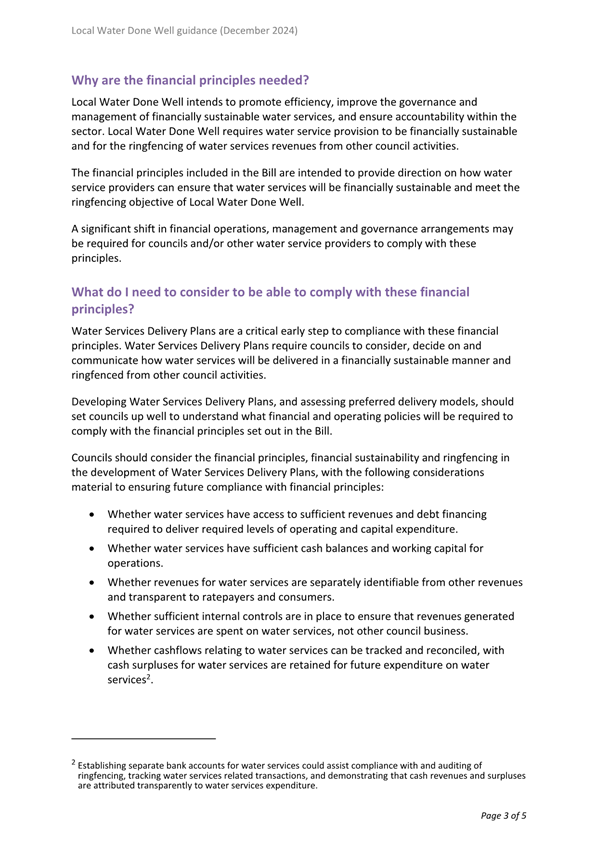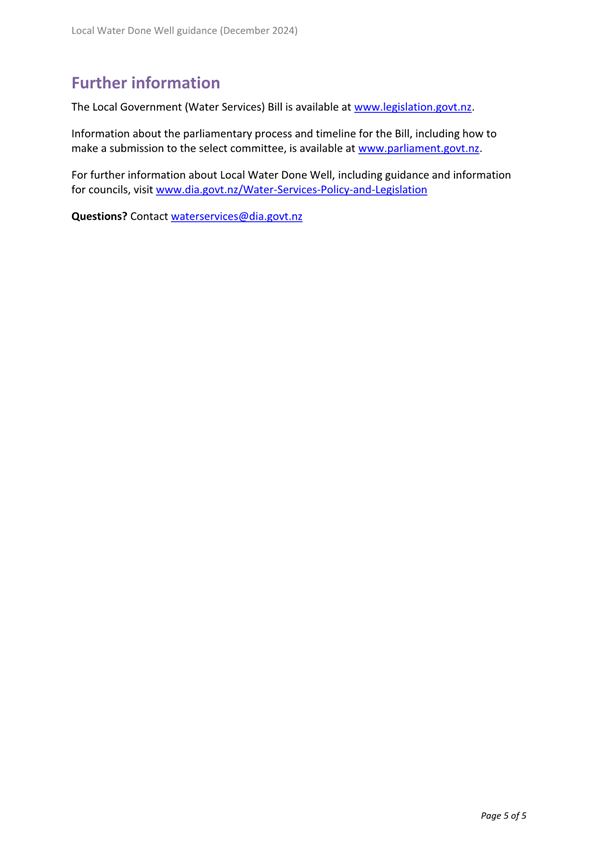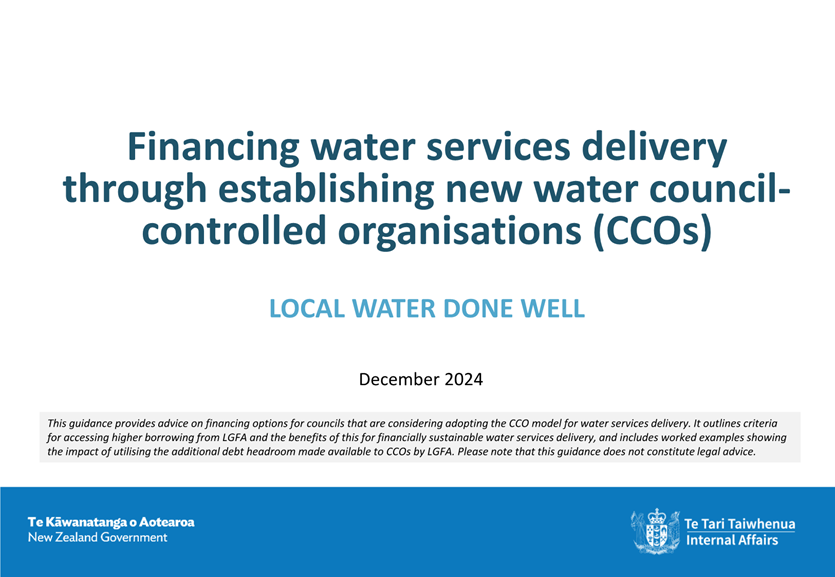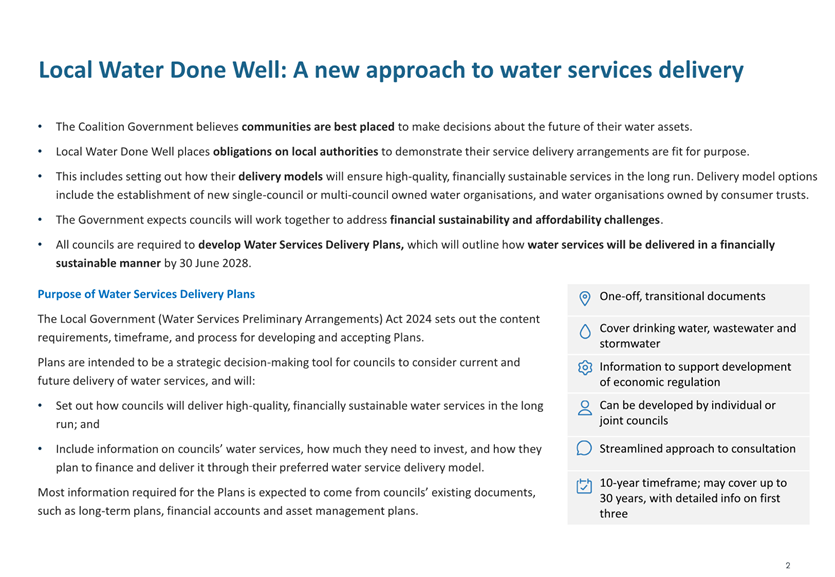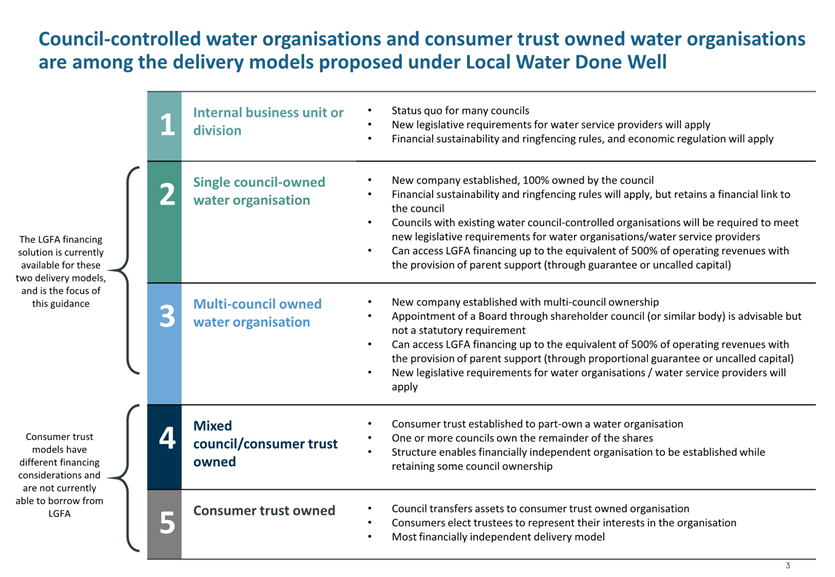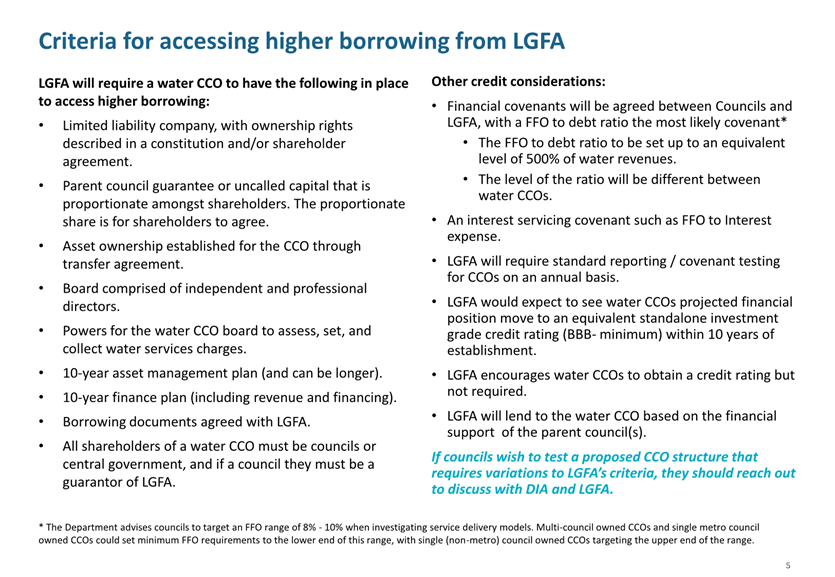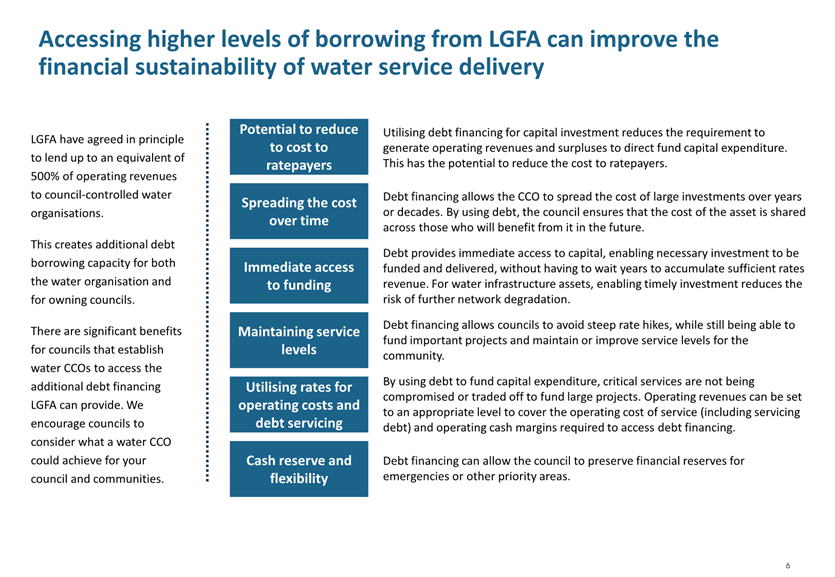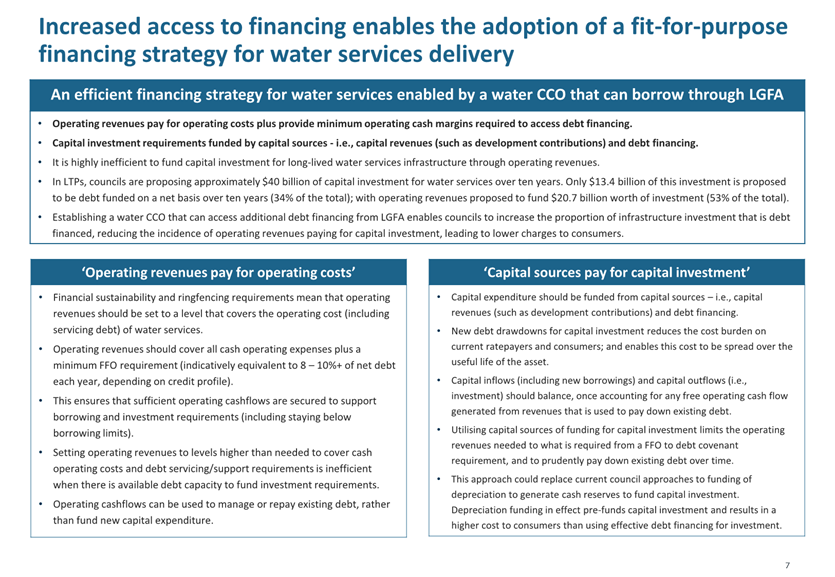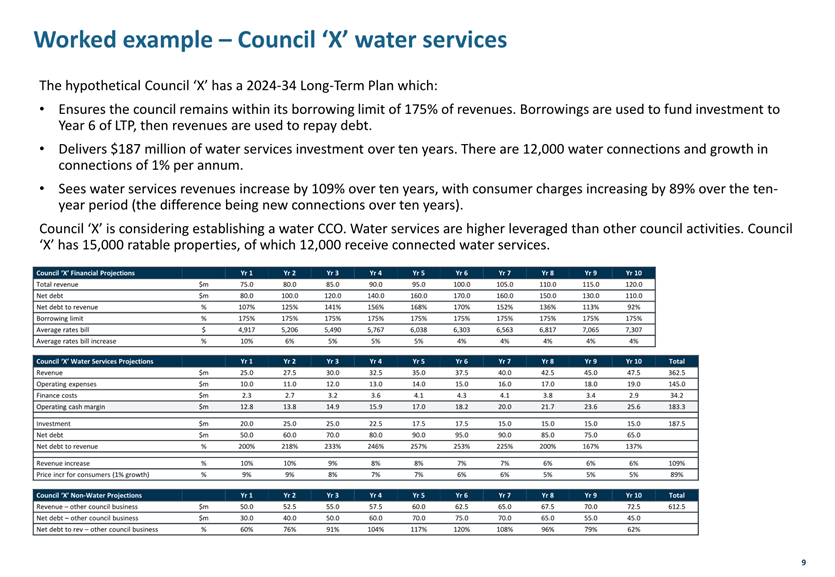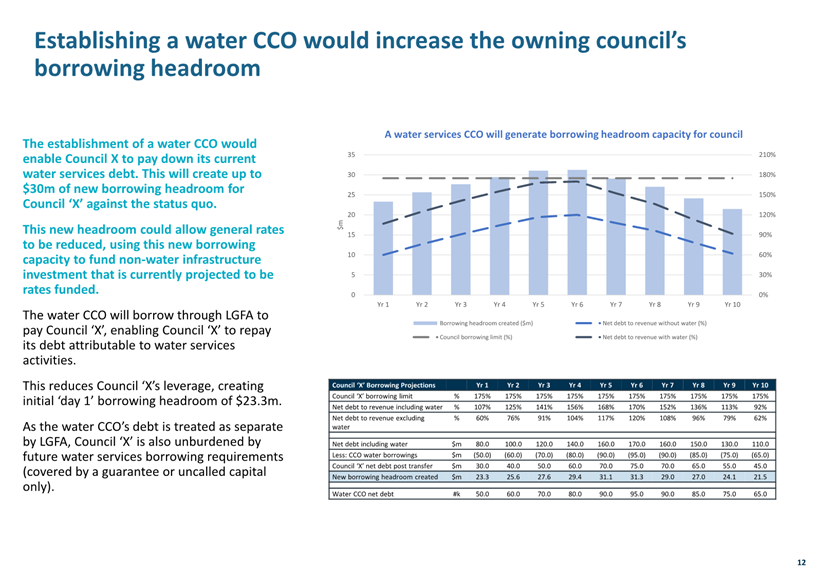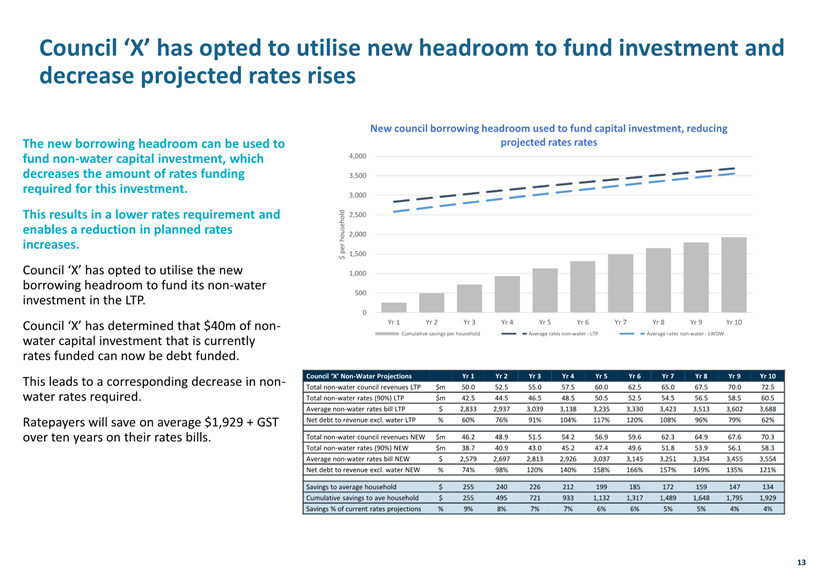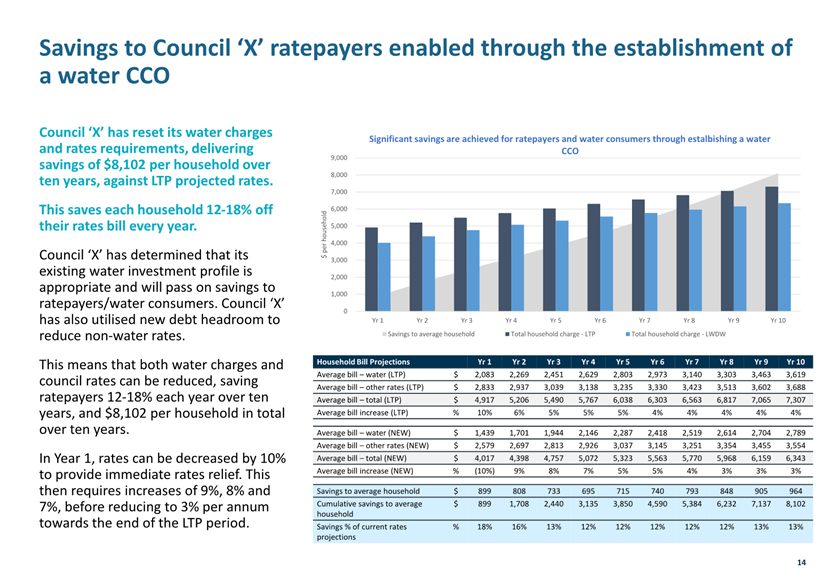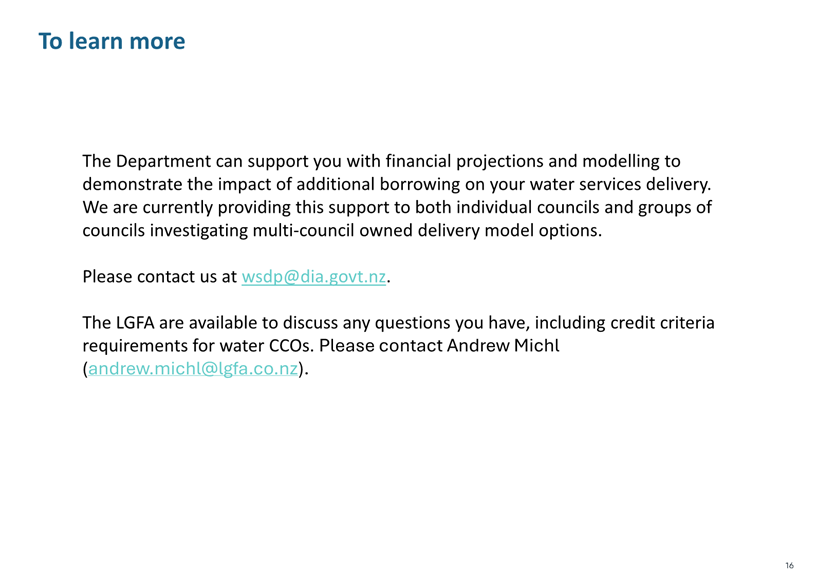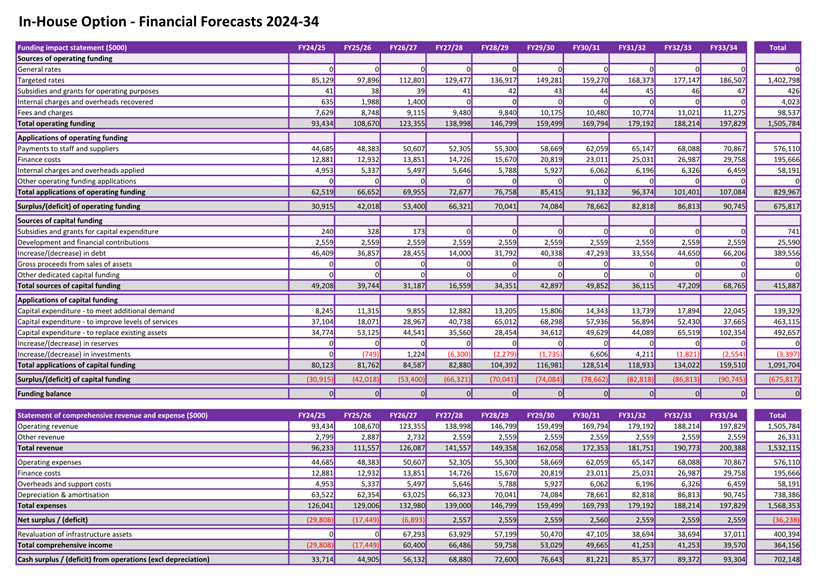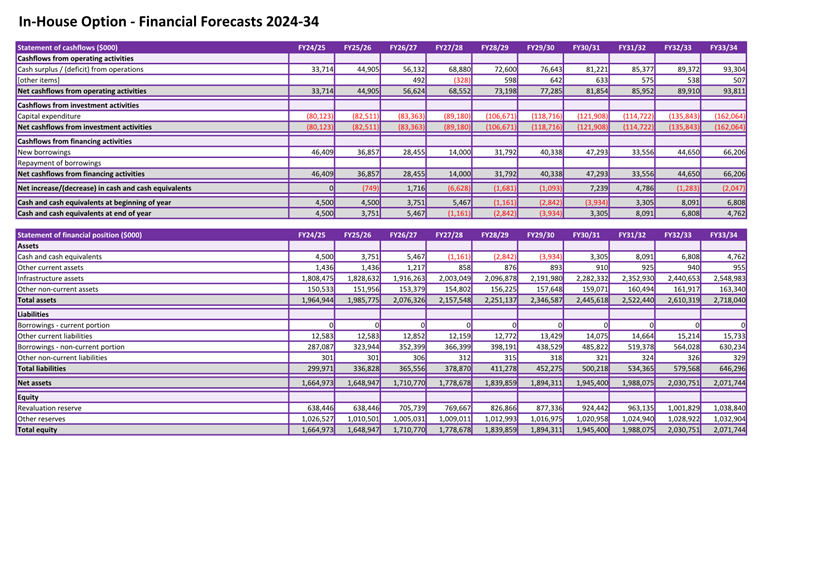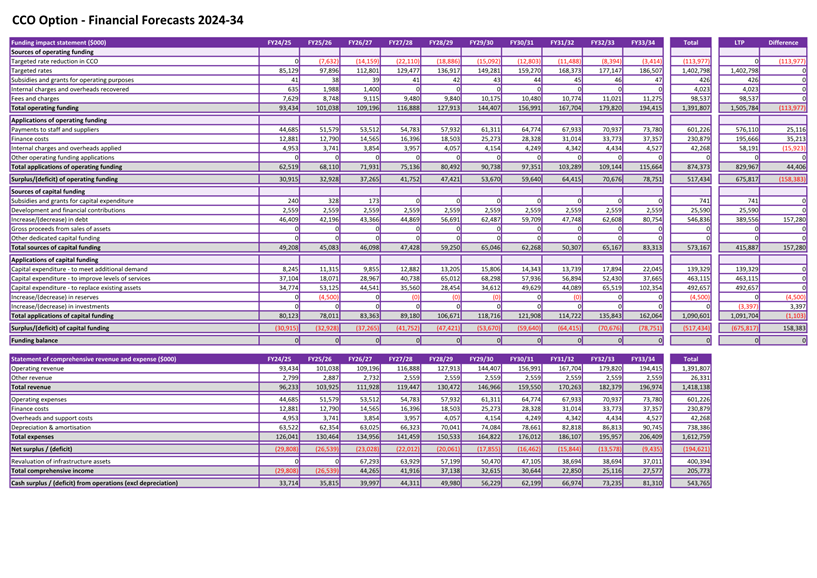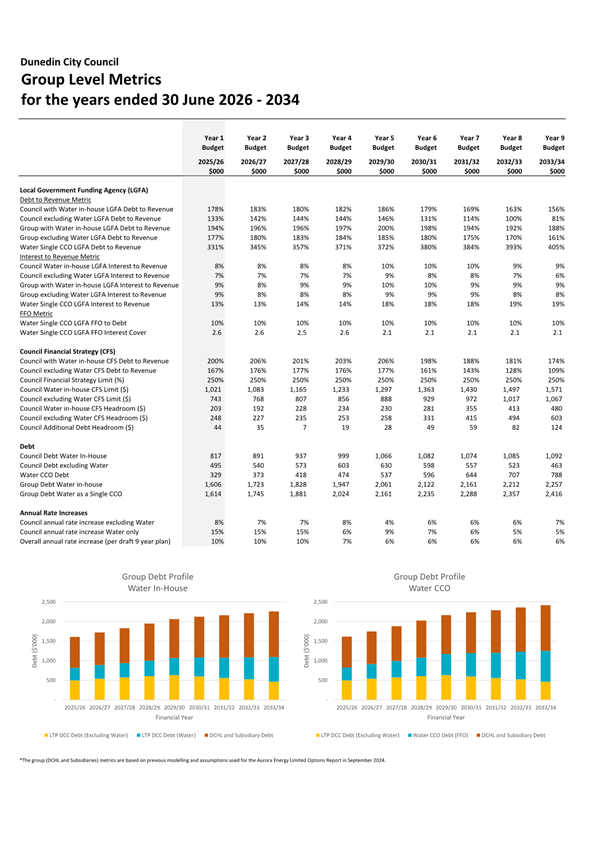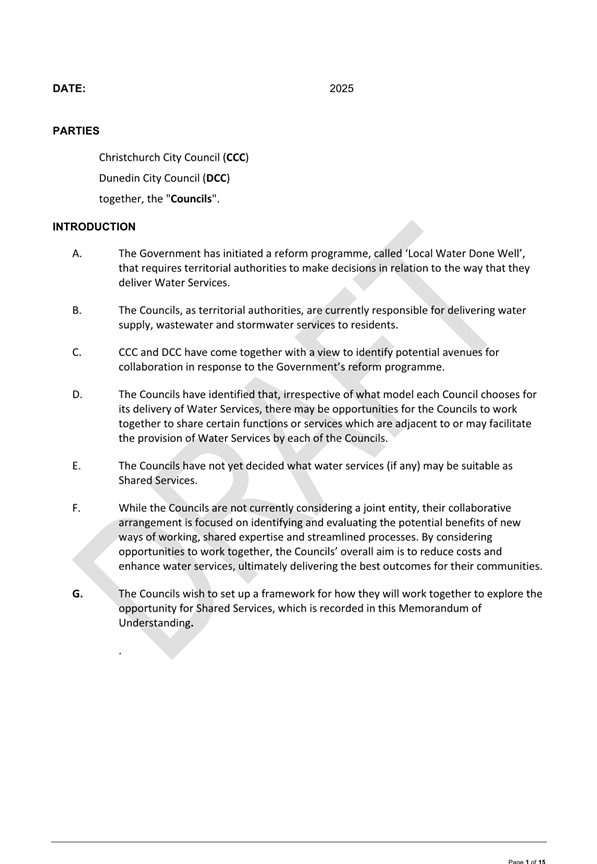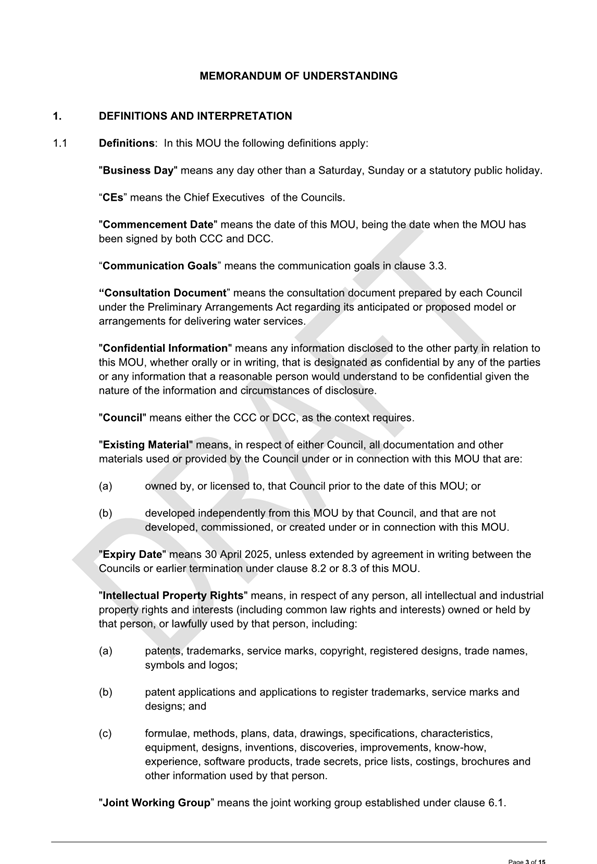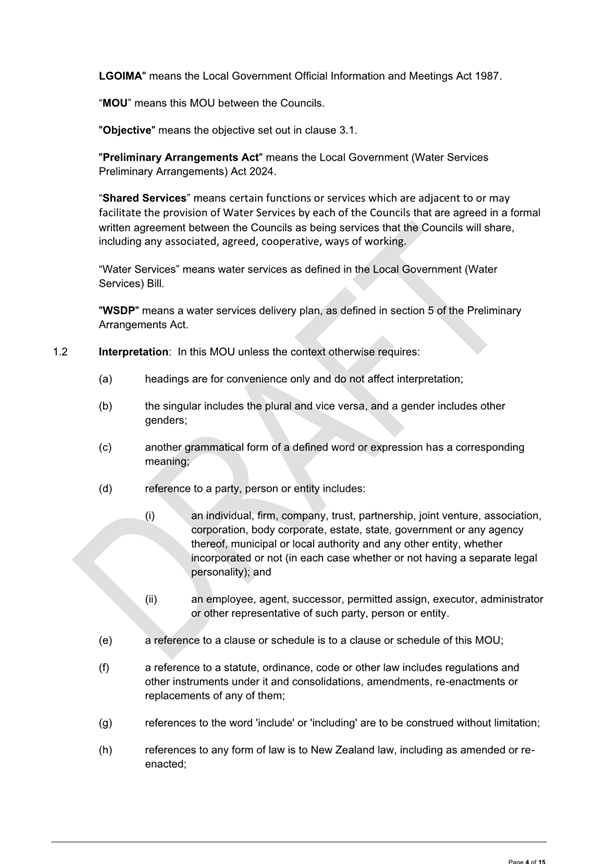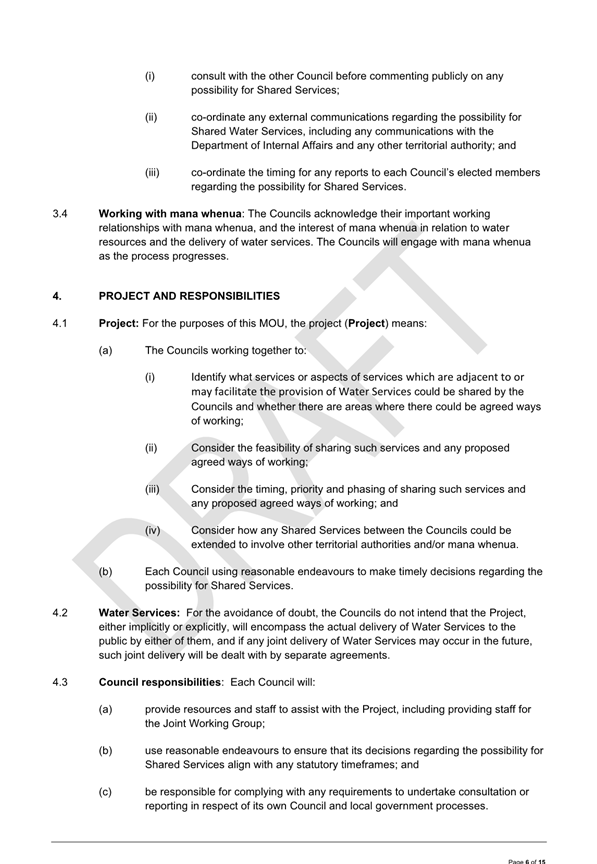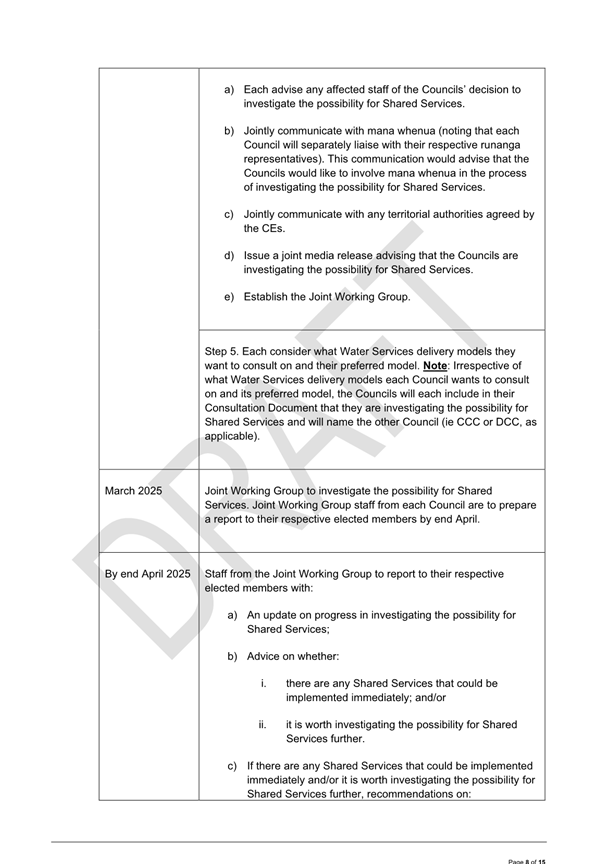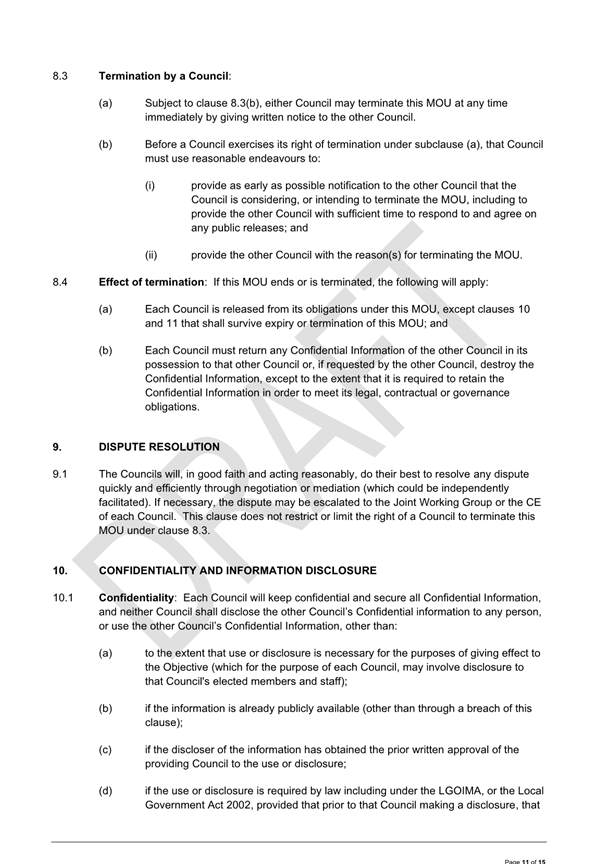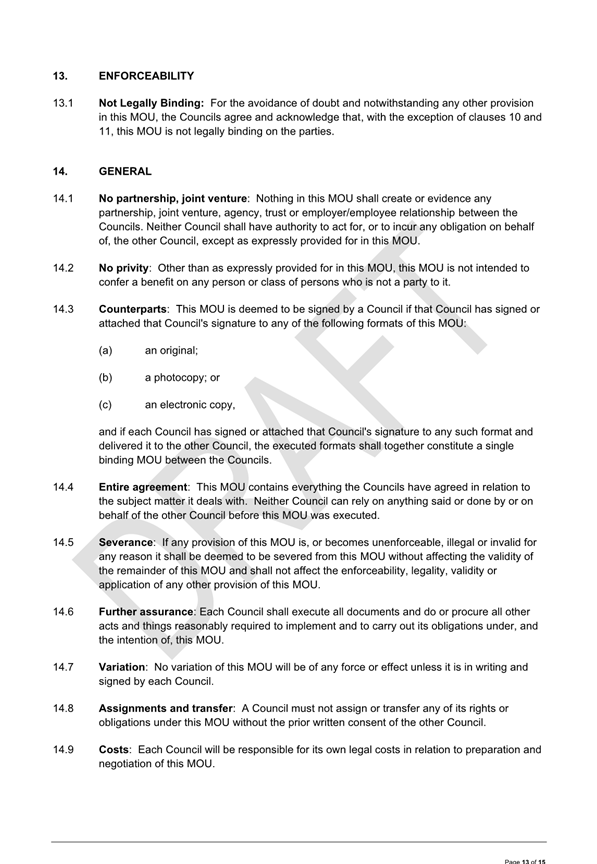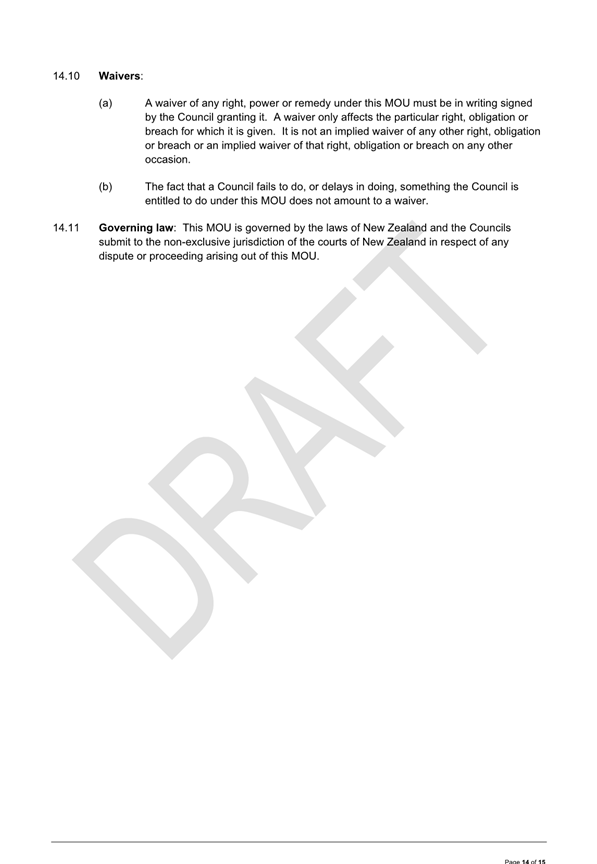|

|
Council
26 February 2025
|
Reports
Submission on the Local Government (Water Services) Bill
Department: 3 Waters and Legal Services
EXECUTIVE SUMMARY
1 This
report seeks the Council’s approval of a draft Dunedin City Council (DCC)
submission (Attachment A) to Parliament’s Finance and Expenditure Select
Committee on the Local Government (Water Services) Bill (the Bill). The Bill
was introduced to Parliament on 10 December 2024 and referred to
Parliament’s Finance and Expenditure Committee for consideration. The Committee
is due to report back to Parliament on the Bill by 17 June 2025.
2 This
Bill is the third step in a legislative programme designed to give effect to
the Government’s ‘Local Water Done Well’ policy.
3 The
key points from the draft DCC submission relate to:
a) Structural
arrangements;
b) Provision
of water services – operational matters;
c) Planning,
reporting and financial management;
d) Economic
regulation and consumer protection;
e) Taumata
Arowai – the Water Services Regulator;
f) National
Engineering Design Standards for water networks; and
g) Environmental
performance standards and infrastructure design solutions for wastewater and
stormwater systems.
4 The
deadline for submissions on the Bill was 23 February 2025. On 20 December 2024
staff requested an extension from the Finance and Expenditure Committee for a
date after the Council meeting of 26 February 2025. An extension was granted on
29 January 2025, with an extended due date of 2 March 2025.
RECOMMENDATIONS
That the Council:
a) Approves the draft DCC
submission to Parliament’s Finance and Expenditure Committee on the Bill.
b) Authorises the Mayor
and/or his delegate to speak to the submission.
c) Authorises the Chief
Executive to make any minor editorial changes if needed.
BACKGROUND
5 Local
Water Done Well (LWDW) is the Coalition Government’s plan for water
services delivery improvement in New Zealand. LWDW is being implemented in
three stages, each with its own piece of legislation. This Bill is stage three.
6 The
first bill, the Water Services Acts Repeal Act 2024 repealed the previous
Government’s water services reform legislation. The second bill, the
Water Services (Preliminary Arrangements) Act 2024 (Preliminary Act),
established the LWDW framework and the preliminary arrangements for the new water
services system.
7 The
Bill provides for:
a) arrangements
for the new water services delivery system, including both the structural
arrangements and the enduring settings;
b) a new
economic regulation and consumer protection regime for water services; and
c) changes
to the water quality regulatory framework and the water services regulator.
8 The
arrangements for new water services delivery systems include:
a) structural
arrangements for water services provision such as establishment, ownership, and
governance of water organisations;
b) operational
matters such as arrangements for charging, bylaws, and management of stormwater
networks; and
c) planning,
reporting and financial management.
9 The
new economic regulation and consumer protection regime in the Bill is based on
existing economic regulation in the Commerce Act 1986, which already applies to
other industries across New Zealand, e.g., electricity lines services. The
Commerce Commission will also enforce a new “ring-fencing” rule
which requires regulated suppliers to spend the revenue they receive from
providing water services on providing those services.
10 Changes to
the water quality regulatory framework and the water services regulator,
include:
a) change
the Taumata Arowai-the Water Services Regulator Act 2020 to amend the
regulator’s name to ‘Water Services Authority – Taumata
Arowai’;
b) changes to
the Water Services Act 2021 (WSA 2021) designed to reduce the regulatory burden
of the drinking water quality regime and improve proportionality in the
application of regulatory powers;
c) a
change in the approach to Te Mana o te Wai; and
d) enabling
the introduction of environmental performance standards for wastewater and
stormwater networks.
11 The Bill is
available on the New Zealand Legislation website: https://www.legislation.govt.nz. A
summary of the Bill can be found at Attachment B.
12 It is
expected the Bill will be enacted in mid-2025.
DISCUSSION
13 The Bill
enables greater flexibility in terms of delivery models and more provision for
local ownership and influence when compared with previous water reform
legislation. As such, DCC’s draft submission is generally supportive of
the Bill and its enabling approach, specifically around ownership and local
influence.
14 The draft
submission states, however, that Council is concerned that the level of
regulation and widening ministerial influence contained in the Bill could have
the effect of diluting Council control, regardless of which water services
delivery model is adopted.
15 Similarly,
the draft submission also states the Bill’s structural arrangements are
more weighted towards some water service delivery models over others, with what
appears to be council controlled organisations being given more benefits (e.g.,
higher debt level thresholds) than in-house delivery models.
16 The draft
submission urges the Government to ensure that restrictions against
privatisation are enduring, and that local influence is preserved.
Structural
Arrangements
17 The draft
submission questions aspects of the structural arrangements outlined in the
Bill including comprehensive and staged economic regulation and different debt
leverage percentages for different water service models. Of most immediate
concern, however, is the conflicting consultation provisions between the
Preliminary Act and the Bill, and the draft submission requests clarification
to ensure a “Change Proposal” only relates to changes outside the
Water Services Delivery Plan process so that Council is not subject to
unnecessary consultative processes.
18 Further,
the draft submission states the definition of Joint Water Service Provider
Arrangement (JWSPA) is too wide and requests there is a narrowing or
flexibility given to the definition of a JWSPA to ensure simpler shared service
arrangements can be efficiently entered. Further that there is an explicit
exemption for contractual shared service arrangements from the new Change
Proposal provisions.
19 The Bill
provides limited mandated direction on mana whenua participation in water
service delivery. The Bill states that water service providers must act in a
manner that is consistent with Treaty settlement obligations, and shareholding
councils may set expectations for how water organisations conduct its
relations with Māori in the Statement of Expectations. The draft
submission urges the Select Committee to consider amending the Bill to mandate
engagement with Māori in line with other legislation e.g., Local
Government Act 2002, as well as a requirement to include Māori
representation on the board of a water organisation.
Provision of
Water Services – Operational Matters
20 The Bill
provides tools designed to improve operational efficiencies and manage risks,
including management plans and bylaws relating to drinking water catchments,
trade waste and stormwater networks (including private watercourses). The draft
submission states that, given the complexities of stormwater, further
consideration is needed in relation to the integration of its management with
asset owners, property owners and regulators, the management transport
corridors, infrastructure maintenance, and how charging for stormwater may
work.
21 The Bill
requires water service providers to produce a drinking water catchment plan, a
trade waste plan, and stormwater network risk management plan in the first two
years after the Bill’s enactment. Within the same timeframe, all water
services bylaws must also be identified and reviewed. A plan must also be developed
for each where they are either amended, revoked, or revoked and replaced.
22 Given the
high volume of work for water service providers within the first two years post
enactment of the Bill, relating to reviewing and/or preparing new bylaws and
producing management plans, the draft submission requests some leniencies on
timeframe given resource limitations.
23 The Bill
specifies who can be charged for water services as the customer. These
provisions are consistent with the provisions in the Local Government (Rating)
Act 2002 that set out who is liable to pay rates. The draft submission supports
this approach.
24 The Bill
allows for the Crown to be exempt from paying development contributions. The
draft submission opposes Crown exemption and states that any entity putting a burden
on the system should be liable for development contributions.
Planning,
Reporting and Financial Management
25 The Bill
sets out new planning, reporting and financial management requirements for all
water service providers. The requirements include a statement of expectations
(for shareholders to provide to water organisations), a water services strategy,
water services annual budget, and a water services annual report.
26 The draft
submission states that Council acknowledges the principle of separate planning,
reporting and financial management to ensure that money collected for the
delivery of water services is spent on water. However, Council questions
whether the new planning and accountability framework is another example of
prescriptions within the Bill that are more weighted towards some models over
others.
Economic
Regulation and Consumer Protection
27 The Bill
provides for the establishment of an economic and consumer protection system to
be overseen by the Commerce Commission. Water service providers would be
subject to core regulatory requirements, including information disclosure
requirements, and may be subject to further regulation as determined by the
Commerce Commission.
28 The draft
submission states Council is generally supportive of the new economic
regulation framework for water services, but that it considers the scope and
scale of the Commerce Commission’s economic regulation activities should
be tailored to the water service provider’s delivery model.
29 Further,
the draft submission states that the level of oversight that is proposed for
the Commerce Commission may be higher than is necessary in cases where
territorial authorities adopt a delivery model that retains a high degree of
control (e.g., in-house delivery). Council notes that the existing
‘in-house’ delivery model for water services already has several
checks and balances that contribute to achieving the objectives of the proposed
economic regulation system.
Taumata
Arowai – the Water Services Regulator
30 The Bill
would amend existing legislation to change the name of Taumata Arowai –
the Water Services Regulator. These amendments would give effect to the
Government’s preference for Government agencies to have an English
language name first. The draft submission expresses support for retention of
‘Taumata Arowai’ as the primary name for the water services
regulator / authority.
31 Parts of
the Bill have been designed to reduce the cost and burden for drinking water
suppliers associated with complying with the WSA 2021. These include:
a) adding a
requirement to take compliance costs into account in Taumata Arowai’s
operating principles;
b) adding scope for
Taumata Arowai to grant general exemptions to drinking water suppliers from
regulatory requirements in order to provide flexibility where compliance is
impractical, inefficient, unduly costly or unduly burdensome;
c) excluding
‘shared domestic drinking water supplies’ (i.e., supplies servicing
up to 25 consumers for domestic use) from the requirements of the drinking
water regulatory system;
d) excluding
community drinking water supplies serving fewer than 25 consumers from the
requirement to have a drinking water safety plan; and
e) adding a
definition of ‘mixed-use rural water scheme’ and requirements for
Taumata Arowai to tailor aspects of its regulatory approach to these supplies.
32 The draft
submission states that although Council recognises the proposed changes are
likely to be pragmatic and will likely reduce costs, it is concerned the
changes should not come at the expense of drinking water safety outcomes. This
is particularly the case in communities serviced by domestic self-suppliers or
shared domestic drinking water suppliers that may be more vulnerable to
drinking water safety issues.
33 The draft
submission also states the Council does not support the proposed amendment to
the WSA 2021 that would remove the requirements for Taumata Arowai and water
service providers to give effect to the Te Mana o te Wai hierarchy of
obligations. Council is concerned this may have an adverse effect on the health
of freshwater and associated values, including mana whenua and drinking water values.
National
Engineering Design Standards for Water Networks
34 The Bill
reintroduces the National Engineering Design Standards (NEDS) for water
services networks. The NEDS, which were part of the previous reform, would
provide mandatory technical standards for the design, construction and
operational performance of infrastructure and process. The draft submission
supports the reintroduction of the NEDS, however, it requests further
information regarding the timing of these standards given their significant
impact on water service providers’ workstreams.
Environmental
Performance Standards and Infrastructure Design Solutions for Wastewater and
Stormwater Systems
35 The Bill
proposes a suite of changes designed to reduce the costs and increase the
efficiency of consenting and operating wastewater and stormwater systems. These
include:
a) amendments
to Taumata Arowai’s existing powers to make environmental performance
standards for wastewater and stormwater networks – these would be single
(not maximum or minimum) standards that would be implemented through resource
consents; and
b) providing
Taumata Arowai with powers to introduce infrastructure design solutions, which
would set
out design and operating requirements for wastewater treatment plants (or
components of wastewater treatment plants) that – if implemented –
would meet applicable wastewater environmental performance standards.
36 The draft
submission states that these changes are pragmatic, however, additional
opportunities should be provided for interested parties to participate in the
process of making environmental performance standards and infrastructure design
solutions for wastewater and stormwater systems.
37 Further,
the draft submission states that following a robust process to develop the
content of these tools will reduce the risk that their implementation
unintentionally leads to adverse effects on environmental or cultural values.
OPTIONS
Option One – Submit on the Local Government (Water
Services) Bill (Recommended Option)
38 Approve,
with any suggested amendments, the draft submission to the Finance and
Expenditure Select Committee on the Local Government (Water Services) Bill
(Attachment A).
39 There is no
impact on debt, rates, and city-wide and DCC emissions.
Advantages
· Opportunity
to provide feedback on implementation of the Government’s ‘Local Water
Done Well’ plan.
· Opportunity
to recommend changes to Parliament’s Finance and Expenditure Committee on
particular provisions of the Bill.
Disadvantages
· There
are no identified disadvantages for this option.
Option Two – Do not submit on the Local Government
(Water Services) Bill
40 Do not
approve the draft submission (Attachment A).
41 There is no
impact on debt, rates, and city-wide and DCC emissions.
Advantages
· There
are no identified advantages for this option.
Disadvantages
· Missed
opportunity to provide feedback on implementation of the Government’s
‘Local Water Done Well’ plan.
· Missed
opportunity to recommend changes to Parliament’s Finance and Expenditure
Committee regarding the provisions of the Bill.
NEXT STEPS
42 If
approved, the draft submission will be finalised and sent to Parliament’s
Finance and Expenditure Committee by 2 March 2025.
Signatories
|
Author:
|
Katherine Quill - Policy Analyst
Scott Campbell - Regulation and Policy Team Leader
Nadia McKenzie - In-House Legal Counsel
|
|
Authoriser:
|
David Ward - General Manager, 3 Waters and Transition
Karilyn Canton - Chief In-House Legal Counsel
|
Attachments
|
|
Title
|
Page
|
|
⇩a
|
Draft DCC submission -
Local Government (Water Services) Bill
|
13
|
|
⇩b
|
Summary of the Local
Government (Water Services) Bill
|
26
|
|
SUMMARY OF CONSIDERATIONS
|
|
Fit with purpose of Local Government
This decision enables democratic local
decision making and action by, and on behalf of communities,
and promotes the social, economic,
environmental and cultural well-being of communities in the present and for
the future.
|
|
Fit with strategic framework
|
|
Contributes
|
Detracts
|
Not applicable
|
|
Social Wellbeing Strategy
|
☐
|
☐
|
✔
|
|
Economic Development Strategy
|
☐
|
☐
|
✔
|
|
Environment Strategy
|
✔
|
☐
|
☐
|
|
Arts and Culture Strategy
|
☐
|
☐
|
✔
|
|
3 Waters Strategy
|
✔
|
☐
|
☐
|
|
Future Development Strategy
|
✔
|
☐
|
☐
|
|
Integrated Transport Strategy
|
☐
|
☐
|
✔
|
|
Parks and Recreation Strategy
|
☐
|
☐
|
✔
|
|
Other strategic projects/policies/plans
|
✔
|
☐
|
☐
|
This report has been prepared with reference to the
Dunedin strategic framework.
|
|
Māori Impact Statement
The draft submission urges Parliament to further mandate
engagement by water service providers with Māori in line with other
existing legislation. The draft submission also states it does not support
the proposed amendment to the Water Services Act 2021 that would remove the
requirements for Taumata Arowai and water service providers to give effect to
Te Mana o te Wai hierarchy of obligations.
|
|
Sustainability
Financial sustainability of local government water
services is a key objective of the Government’s “Local Water Done
Well” plan. The suite of legislation is designed to implement this
programme and ensure delivery of water services is financially sustainable.
The draft submission states it does not support the
proposed amendment to the Water Services Act 2021 that would remove the
requirements for Taumata Arowai and water service providers to not give
effect to Te Mana o te Wai hierarchy of obligations, as this may have an
adverse effect on environmental values.
The draft submission also states that a robust process
needs to be followed when developing the content of the Environmental
Performance Standards and Infrastructure Design Solutions for Wastewater and
Stormwater Systems to ensure there are no adverse effects on the environment.
|
|
Zero carbon
There
is no impact on city-wide or DCC emissions directly associated with this
report and the decision to approve the draft submission to Parliament’s
Finance and Expenditure Committee.
|
|
LTP/Annual Plan / Financial Strategy /Infrastructure
Strategy
This report and the decision to approve the submission to
Parliament’s Finance and Expenditure Committee have no direct implications
for these plans and strategies.
|
|
Financial considerations
There are no financial implications directly associated
with this report and the decision to approve the draft submission to
Parliament’s Finance and Expenditure Committee.
|
|
Significance
The decision to approve the draft DCC submission is
considered low in terms of the Council’s Significance and Engagement
Policy.
|
|
Engagement – external
A workshop was held with Councillors on Friday 14 February
2025 to inform the development of the draft submission. The workshop was open
to the public.
|
|
Engagement - internal
Staff from the Legal Team, 3 Waters Group, and Executive
Leadership Team have contributed to the development of the draft DCC
submission.
|
|
Risks: Legal / Health and Safety etc.
There are no identified risks directly related to the DCC
submission on the Local Government (Water Services) Bill.
|
|
Conflict of Interest
There is no known conflict of interest.
|
|
Community Boards
Community Boards are likely to be interested in the
proposed water services delivery changes and staff will consider how to
update the Community Boards.
|
|

|
Council
26 February 2025
|
Local Water Done Well - Decision on water
models for consultation
Department: Legal Services, Finance and 3 Waters
EXECUTIVE SUMMARY
1 The
purpose of this report is to provide information and analysis so that Council
can decide, for the purposes of consultation, on:
a) its
preferred water services delivery model (Preferred Option); and
b) what
other option(s) it will consult on (Alternative Option(s))
(together, referred to as “the Water Consultation
Options”).
2 Staff
recommend the following two options as the Water Consultation Options:
a) in-House
delivery of 3 Waters (In-House Option); and
b) an
asset owning council-controlled organisation for 3 Waters, with Council as the
sole shareholder (CCO Option).
3 It
is for Council to decide whether it prefers the In-House Option, the CCO Option
or any other option. This will require careful weighting by Council of
financial and non-financial considerations.
4 This
report provides detailed information to help inform Council’s decision,
including information on:
a) Financial
and non-financial considerations;
b) the
Local Government (Water Services Preliminary Arrangements) Act 2024
(Preliminary Act); and
c) the
Local Government (Water Services) Bill 2024 (December Bill).
5 There
are a lot of acronyms and definitions used in the context of water
reforms. A glossary is attached as Attachment A.
RECOMMENDATIONS
That the Council:
a) Decides to consult on the following two options under the Local
Government (Water Services Preliminary Arrangements) Act 2024:
i) In-House delivery of 3 Waters (the
In-House Option); and
ii) An asset owning CCO for 3 Waters, with
Council as the sole shareholder (the CCO Option).
b) Decides that its Preferred Option for consultation is the In-House Option.
c) Notes that there will be a report to Council on 18 March 2024
asking Council to approve the water options consultation document.
BACKGROUND
Water
Services Reform
Local Water Done
Well
6 The
Government is now in the final stage of their three-stage process implementing
its “Local Water Done Well” (LWDW) reform programme.
7 The
first stage of LWDW saw the repeal of legislation relating to large water
services entities. This was in February 2024.
8 The
second stage of LWDW was implemented with the passing of the Preliminary Act on
2 September 2024. As a result, Council is required to prepare and submit a WSDP
to the Secretary for Local Government by 3 September 2025.
9 The
third stage of LWDW is now underway with the introduction of the December Bill
on 10 December 2024. The December Bill provides the enduring settings for LWDW
including the framework for economic regulation as well as the more detailed
powers and duties for service delivery models.
10 Further
information on the Preliminary Act and the December Bill is included later in
this report.
Requirement for a
Water Services Delivery Plan
11 Council’s
immediate action resulting from the Preliminary Act is to prepare and submit a
WSDP to the Secretary for Local Government by 3 September 2025.
12 As
reported to Council in earlier reports, the WSDP requires information on the
WSDM including:
a) the
anticipated or proposed WSDM or arrangements for delivering water services;
b) a
summary of consultation undertaken as part of developing the WSDM; and
c) an
implementation plan for delivering the WSDM.
13 If
Council decided to enter a joint arrangement with one or more other territorial
authorities, it could choose to prepare and submit a joint WSDP.
14 There
is an opportunity to amend a WSDP within a specified timeframe if the proposed
amendments are significant and necessary due to exceptional circumstances.
15 Council
is required by law to give effect to the proposals or undertakings specified in
the WSDP. Not doing so could be a ground for appointing a Crown
facilitator.
Timeline and Process
16 DIA’s
implementation roadmap for LWDW is shown at Attachment B.
17 DIA
has also provided a high-level roadmap for Council’s planning and
delivery, as shown at Attachment C.
18 Staff
have presented on the WSDP (including on possible WSDMs) to Council at various
workshops and meetings since the passing of the Preliminary Act on 2 September
2024. Council adopted a shortlist of three WSDM options at its Council meeting
on 25 November 2024: https://infocouncil.dunedin.govt.nz/Open/2024/11/CNL_20241125_AGN_3009_AT_WEB.htm
An
overview of the December Bill
19 The
December Bill is currently going through the Parliamentary process and will be
subject to amendment. It is anticipated that the December Bill will be enacted
in mid-2025 and that most of the content will come into effect the day after
Royal Assent.
20 Staff
have prepared a draft submission on the December Bill. Councillors have had the
opportunity to provide feedback through a workshop. Adoption of the submission
is the subject of another Council Report on 26 February 2025.
21 It
is expected that the December Bill will be divided during the Parliamentary
process into two separate Bills (perhaps intended to separate the standalone
provisions of the December Bill and the amendments to several other Acts). The
two likely names of the separate Bills are:
a) Local
Government (Water Services) Bill; and
b) Local
Government (Water Services Repeals and Amendments) Bill.
22 DIA
has now updated its guidance materials given the introduction of the December
Bill (Guidance). A copy of the updated Guidance can be found at https://www.dia.govt.nz/Water-Services-Policy-Future-Delivery-System#Financing.
Specific factsheets have also been referred to through this report. Further
general information on LWDW is also available on the DIA website: https://www.dia.govt.nz/Water-Services-Policy-and-Legislation
.
23 As
expected, the December Bill is comprehensive covering all aspects of the new
water services delivery system and delivery entities. Specific impacts on the
options presented in this report are discussed throughout this report. A
Summary of the key themes of the December Bill (as previously provided to
Councillors) is included at Attachment D.
Preliminary
Act
24 As
presented to Council in earlier reports, the Preliminary Act prescribes the
process that Council must use for decision making and consultation on the WSDM.
25 Council
is not required to comply with the corresponding requirement in the Local
Government Act 2002 (LGA 2002) where an alternative process under the
Preliminary Act applies.
26 The
options presented in this report comply with the Preliminary Act.
Requirement to
identify at least two potential options
27 The
Preliminary Act specifies that, during decision making, the Council:
a)
Must identify both of the following two options for delivering
water services:
i) Remaining
with the existing approach for delivering water services; and
ii) Establishing,
joining, or amending (as the case may be) a water services CCO (WSCCO) or a
joint local government arrangement.
b) May
also identify additional options for delivering water services and must assess
the advantages and disadvantages of all options identified.
Information to be
included in Consultation Document
28 During
consultation, Council must make the following information publicly available:
a) The proposal (being the Preferred Option), an explanation of the
proposal and the reasons for the proposal.
b) An analysis of the reasonably practicable options,
which must include:
i) the
option to remain with the existing approach for delivering water services; and
ii) the
option to establish, join or amend (as the case may be) a water services CCO
(WSCCO) or a joint local government arrangement.
c) How
proceeding (or not) with the proposal is likely to affect Council’s
rates, debt, levels of service and water services charges.
d) Community
implications (if joint) and accountability/monitoring arrangements (if assets
transferred).
e) Any
other relevant implications of the proposal that Council considers will be of
interest to the public.
Potential
for shared services
29 Under
either the In-House or CCO Options, there is the potential to add shared water
services. There is a separate report to Council on 26 February 2025 regarding a
proposed memorandum of understanding between the Dunedin City Council and the
Christchurch City Council to investigate the possibility of shared water
services.
Overlapping
consultation with the 9 Year Plan
30 Council
is only required to consult once but may decide to undertake further
consultation before deciding on a WSDM.
31 Consultation
on the Water Consultation Options is a separate process from the 9YP
consultation process. Consultation on the Water Consultation Options will be
under the Preliminary Act whereas consultation on the 9YP will be under the LGA
2002.
32 There
will be one consultation document for the 9YP and another consultation document
for the Water Consultation Options. Each consultation document will cross
reference the other.
33 Given
that a decision on the Water Consultation Options has the potential to impact
the 9YP, there will be combined Hearings in May for both the 9YP and the Water
Consultation Options.
Consultation
requirements with mana whenua
34 Council
is required to consult with mana whenua under both section 77(1)(c) and section
81 of the LGA 2002 given both references are included under section 60 of the
Preliminary Act. Further, section 14(1)(d) of the LGA 2002 also provides that a
local authority should provide opportunities for Māori to contribute to
its decision-making processes.
Decision
Making on a Change Proposal (after enactment of the December Bill)
35 The
December Bill, as currently drafted, includes new decision-making requirements
if there is a “Change of Proposal”. This would only apply following
enactment of the December Bill (mid-2025).
36 A
Change Proposal includes things like establishing a council-controlled
organisation (CCO) or agreeing on shared services with another territorial
authority.
37 If
a Change Proposal is triggered, Council would need to consult on three options;
being the existing approach, the change proposal and at least one further
reasonably practicable option, if available.
38 This
contrasts with the minimum of two options under the Preliminary Act.
39 There
is some uncertainty on whether Council would be required to re-consult if
Council decided on the CCO Option for its WSDP and the CCO was not established
until after enactment of the December Bill. However, DIA has indicated by
e-mail to staff that the new decision-making requirements in the December Bill
are intended to apply to future decisions by Council outside
current decision making required to inform the WSDP. Staff are hoping that the
December Bill will be amended to clarify this.
40 If
Council decided on the In-House Option for its WSDP and then later (for
example, in 2 years’ time) decided that it wanted the CCO Option then,
based on the current drafting of the December Bill, Council would need to go
through a fresh consultation process.
Legal
Requirements for Water Service Providers
41 As
noted in earlier reports:
a) A
‘water organisation’ means the separate organisation that
territorial authorities may establish or be shareholders in, and which provides
water services in accordance with transfer agreements. A water organisation
does not include the in-house model. An example of a water organisation is a
CCO.
b) A
‘water service provider’ is a wider term and means water
organisations and territorial authorities. In other words, a water
service provider includes both the in-house model and models such as the CCO
model.
42 Legislative
requirements are set out in the December Bill for all water service providers.
Additional requirements are included for water organisations. Both sets of
requirements are described below.
All Water Service
Providers
43 The
requirements for all water service providers (including in-house delivery)
broadly follow earlier DIA guidance with some updates.
44 The
following summary of these core requirements is taken from the DIA Guidance.
Staff have provided further detail on each requirement at Attachment E:

Additional
Requirements for Water Organisations
45 Additional
requirements also apply to those councils forming a water organisation e.g., a
CCO. These are set out in the Guidance as below including a new requirement
relating to a transfer agreement:

46 It
is possible to apply for exemptions from the marked (*) requirements on a
case-by-case basis through a legislated process.
DISCUSSION
PART A: Which base models does
Council want to consult on?
47 At
Council’s meeting on 25 November 2024, Council decided to shortlist three
base WSDMs:
a) In-House
Delivery;
b) Single
CCO; and
c) Regional
Multi-Council Entity
(the “shortlist”).
48 Some
initial explanations and comparative analysis on the Shortlist were discussed
in the November Report and included some advantages and disadvantages for each:
https://infocouncil.dunedin.govt.nz/Open/2024/11/CNL_20241125_AGN_3009_AT_WEB.htm
49 Following
Council’s decision on the Shortlist, there have been discussions with
staff at Christchurch City Council regarding the potential for shared water
services. This is discussed in a separate report to Council, also on the agenda
for 26 February 2025. The intention is to manage shared services through
contracts rather than a multi-council entity.
50 There
have also been discussions with other territorial authorities, but those
discussions have not progressed to the stage where there is an identified
practicable option suitable for consultation. Without knowing who the
participants would be in a Regional Multi-Council Entity, it is difficult to
provide any further analysis than what has already been provided through the
Morrison Low Report dated 24 October 2024. The Morrison Low report was attached
to the November
Report.
51 As
part of considering the Shortlist, staff have considered whether a two waters
CCO may be a reasonably practicable option or whether it would be reasonably
practicable to use one of Council’s existing CCOs for the delivery of
water services. For a variety of reasons, these two variations on the CCO
Option have not been considered further because they are not seen as being
reasonably practicable options.
52 Staff
consider that the “reasonably practicable options” under the
Preliminary Act are:
a) the
In-House Option; and
b) the
CCO Option.
Part B: Which is Council’s
Preferred Option?
53 Council
will need to carefully weigh a variety of financial and non-financial
considerations before deciding on its preferred WSDM.
Summary of Financial Considerations
Financially
Sustainable
54 A
WSDP needs an explanation of:
a) How
revenue from and delivery of water services will be separated from the
territorial authority’s other functions and activities; and
b) How
Council proposes to ensure delivery of water services will be financially
sustainable by 30 June 2028.
55 The
December Bill specifies the financial principles for water service providers.
The financial principles support the ringfencing objectives of LWDW and are
supported by DIA guidance: “Ensuring compliance with financial principles
for water service providers” (Attachment F). The December Bill also includes
objectives to ensure water services are provided in a cost-effective and
financially sustainable manner.
56 Ringfencing
of water services is critical for financial sustainability and revenue sufficiency. The DIA guidance states that
ringfencing requires:
a) Water
revenues be spent on water services; and
b) Water
services charges and expenses be transparent and accountable.
57 The
Preliminary Act defines ‘financially sustainable’, in relation to a
council’s delivery of water services, as:
a) The
revenue applied to the council’s delivery of those water services is
sufficient to ensure the council’s long-term investment in delivering
water services; and
b) The
council is financially able to meet all regulatory standards and requirements
for the council’s delivery of those water services.
58 The
DIA Guidance suggests three components to assessing financial sustainability.
How councils approach achieving financial sustainability can be different
depending on local circumstances and requires councils to consider the balance
between the three components:
a) Revenue
sufficiency - having sufficient revenue to cover the costs (including servicing
debt) of water services delivery.
b) Investment
sufficiency - having a sufficient level of investment to meet levels of
service, regulatory requirements and provide for growth.
c) Financing
sufficiency - having sufficient funding and financing arrangements to meet
investment requirements.
59 The
DIA Guidance makes further recommendations about how councils can demonstrate
ringfencing. It also provides further information about financial
sustainability as well as providing a template for financial projections and a
financial sustainability test (See DIA link https://www.dia.govt.nz/diawebsite.nsf/Files/Water-Services-Policy/$file/Guidance-for-preparing-Water-Services-Delivery-Plans-September-2024.pdf).
60 Further
DIA guidance: “Financing water services delivery through establishing new
water CCOs” (Attachment G) provides advice on financing options for
councils considering the CCO model for water services delivery. The guidance
outlines criteria for accessing higher borrowing from the Local Government
Funding Agency (LGFA).
Financial Analysis
61 The
following financial analysis has been prepared to support Council’s
decision making in preparation of the WSDP. The analysis does not provide the
level of detail required in the WSDP but does provide a level of analysis and
information that demonstrates the financial impacts of each option being
considered.
62 Two
sets of forecast financial statements for the 10 year period 2024-34 have been
prepared:
a) The
In-House Option - as per the approved 2024/25 Annual plan and draft 9 year plan
2025-34 (9 year plan) (Attachment H) and
b) The
CCO Option – a 3 Waters CCO, as at 1 July 2025 (Attachment I).
63 A
series of tables comparing the two options have been included in Attachment J.
64 Although
in practice a CCO probably would not be established until 1 July 2027, the
modelling assumes a date of 1 July 2025 to provide financial comparison over
the longest period possible.
65 The
WSDP requires a minimum of ten years of financial
projections for water services, covering the financial years 2024/25 - 2033/34.
Due to the inherent uncertainties with forecasting, the financial forecasts
provided do not go beyond the 2033/34 year.
66 As
mentioned above, DIA provided a template to use for the financial sections of
the WSDP. This includes financial projections, measures and charts required in
the financial sustainability assessment. Staff have used these templates for
the financial analysis of the two options.
Assumptions
67 Key
assumptions underlying both options are:
a) 1
July 2024 opening balance sheet to ringfence 3 Waters for modelling purposes.
b) The
2024/25 Annual Plan is year 1 (due to the 9 year plan only being 9 years).
c) The
starting point is the draft 9 year plan 2025-34.
d) Total
operating expenditure of $1.568 billion and total capital expenditure of $1.095
billion is forecast over the 9 year plan.
e) No
allowance is made for savings as a result of efficiencies.
68 Each
option assumes additional operating costs as follows:
a) An
increase in staff resourcing to meet new regulatory requirements, customer
service, finance and billing.
b) Additional
levies to Taumata Arowai (Water Services Authority) and the Commerce
Commission.
c) Additional
audit fees for additional financial reporting requirements.
69 The
CCO Option attracts further operational costs, in particular governance and
leadership.
70 Some
corporate costs, including fleet, would shift from Council to the CCO, however
some internal costs could remain as stranded costs within Council and need to
be managed over time. Further work on this is required and will be
underway in the coming months. An update on this work will be provided to
Council in May.
71 LGFA
have agreed in principle to lend up to 500% of operating revenues to a 3 Waters
CCO, creating additional borrowing capacity. The CCO Option assumes access to
this borrowing limit. It also assumes a Funds From Operations (FFO) of 10% of
debt. LGFA has advised that most water CCOs will have a minimum FFO to debt
ratio of between 8% and 12%, depending on credit profile. These will be
negotiated with each water CCO.
72 Transitional
costs need to be accounted for but these are yet to be determined.
73 In
order to ensure compliance with the financial principles and financial
sustainability provisions, current systems (including finance and asset
management) are likely to need investment, for either option. A provisional
amount for this has been included in the 9 year plan.
Funding Approach
74 The
funding approach for the In-House Option aligns with Council’s draft
Financial Strategy and draft 9 year plan as follows:
a) Balanced
budget - the LGA 2002 requires councils to have a balanced budget unless it is
prudent to do otherwise. This means fully funding depreciation, which in turn
is used to pay for capital expenditure. For 3 Waters, the draft 9 year plan
provides 15% per annum rate increases for the first three years leading to a
balanced budget (for 3 Waters) by the 2027/28 year.
b) Debt
limit – Council’s gross debt limit is 250% of revenue. The LGFA
financial covenants limit net debt to 280% of revenue.
75 The
funding approach for the CCO Option follows DIA guidance as follows:
a) Operating
revenues pay for operating costs - DIA guidance indicates that financial
sustainability and ringfencing requirements mean that operating revenues should
be set to a level that covers the operating cost (including debt) of water
services. This ensures sufficient operating cashflows are secured to support
borrowing and investment requirements (including staying below borrowing
limits). Operating revenues, including 3 Waters rates, should cover all cash
operating costs plus a minimum FFO.
b) Capital
sources pay for capital investment - DIA guidance indicates that capital
expenditure should be funded by capital revenues (such as development
contributions) and debt financing.
76 The
DIA guidance on CCO funding states:
“This approach could
replace current council approaches to funding of depreciation to generate cash
reserves to fund capital investment. Depreciation funding in effect pre-funds
capital investment and results in a higher cost to consumers than using
effective debt financing for investment.”
77 The
difference in funding approaches means that under the CCO Option, over the 10
year period modelled, charges to customers could be lower and debt higher. This
is because more debt is used to pay for capital expenditure. For the In-House
Option, more rates income is used to pay for capital expenditure.
In-House Option
78 Under
this option, 3 Waters remains in-house. This option is consistent with the
draft 9 year plan. The key financial outcomes are:
Table 1

a) Operating
revenue (excludes development contributions of $26 million) over the 10 years
is $1.506 billion.
b) Rate
increases of 15% per annum for the first three years, followed by an average of
6% for the remaining years.
c) The
average customer charge per connection (including GST) increases from $2,024 in
2024/25 to $4,280 in 2033/34.
d) Operating
expenditure over the 10 years is $1.568 billion, including interest costs of
$196 million.
e) Net
surplus is achieved in the 2027/28 year.
f) Capital
expenditure over the 10 years is $1.095 billion.
g) 3
Waters debt is $630 million by 30 June 2034.
h) Total
Council debt is $1.092 billion by 30 June 2034. Council debt remains within the
250% debt limit throughout the period. By year 10, debt reaches 174% of
revenue. Council debt remains within the LGFA net debt limit of 280%. By year
10, net debt reaches 156% of revenue.
CCO Option
79 Under
this option, a 3 Waters CCO is established. As indicated above, operating revenue
covers cash operating expenses plus an FFO margin of 10%. The key financial
outcomes are:
Table 2

a) Operating
revenue (excludes development contributions of $26 million) over the 10 years
is $1.392 billion.
b) Annual
increases in water charges range from 5.8% in 2025/26 to 13.1% in 2029/30. The
average price increases over the 9 year plan timeframe is 8.5%.
c) The
average customer charge per connection (including GST) increases from $2,024 in
2024/25 to $4,202 in 2033/34.
d) Operating
expenditure over the 10 years is $1.613 billion including interest costs of
$231 million.
e) The
CCO Option does not achieve a balanced budget during the 10 year period because
operational revenues cover operational cash expenses only (not depreciation)
plus the FFO requirement (modelled at 10%). Over time, as debt and therefore
the FFO requirement increases, the deficit reduces.
f) Capital
expenditure over the 10 years is $1.095 billion.
g) Debt
is $788 million by 30 June 2034. This is within the 500% LGFA net debt limit.
By year 10, debt reaches 405% of revenue.
h) Council
debt excluding 3 Waters is considered in paragraphs 80-83 below.
In-House Option
compared to the CCO Option
80 The
key financial differences between the two options are discussed below. Table 3
summarises financial information for year 10 (2033/34) and the 10 year total
for each of the options.
Table 3

a) Over
the 10 year period, operating revenue under the CCO Option is $114 million less
than the In-House Option. As discussed in paragraph 76 above, charges to
customers are lower. More debt is used to pay for capital expenditure than
under the In-House Option, where more rates funding is used to fund capital
expenditure. The CCO Option would debt fund an additional $157 million over the
10 year period. Chart 1 below shows the profile of operating revenue under each
option over the 10 year period. By the 2033/34 year, operating revenue is $198
million in the In-House Option and $194 million in the CCO Option.
Chart 1

b) The
average charge per connection under both options is provided in Table 4 and
Chart 2 below. The average charge per connection is lower in the CCO Option,
however the difference (saving) reduces as more debt is raised. While this does
not reflect the current charging model, it provides a comparison:
Table 4

Chart 2

c) Annual
increases in charges for water services are higher for the In-House Option for
the first three years of the 9 year plan period (2025/26 – 2027/28),
reflecting Council fully funding depreciation by 2027/28. From the 2028/29
year, the annual increases are higher in the CCO Option. This is illustrated in
the Chart 3 below:
Chart 3

d) Operating
expenditure under the CCO Option is $44 million higher than the In-House Option
due to additional interest ($35 million) and CCO related operational costs
($9 million).
e) Net
surplus/(deficit) is different in each option and this reflects the different
funding approaches. The In-House Option achieves a balanced budget in the
2027/28 year. The CCO Option does not achieve a balanced budget during the 10
year period because operational revenues cover operational cash expenses
only (not depreciation) plus the FFO requirement (modelled at 10%). As debt
increases so does the FFO requirement therefore the deficits will reduce.
f) Capital
expenditure over the 10 year period is the same for each option.
g) Under
the CCO Option, 3 Waters debt is $157 million higher than the In-House Option
due to the reduction in operating revenue and the additional interest and
operating costs. By year 10, net debt reaches 405% of revenue in the CCO Option
and 314% in the In-House Option. The graph below shows the debt to revenue
metric for each option:
Chart 4

Council excluding 3
Waters
81 The
establishment of a CCO for 3 Waters results in Council having less debt. This
would create additional debt headroom compared to the in-house option, as shown
in the two charts below, due to the ratio of revenue to debt improving without
3 waters. The debt limit indicated on each chart is the Council 250% limit.
82 Chart
5 shows the in-house option. The headroom in the 2033/34 year is $480 million.
Chart 5
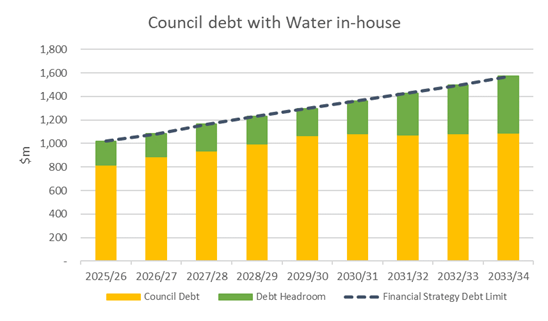
83 Chart
6 shows Council excluding 3 Waters. The headroom in the 2033/34 year is $603
million, $124 million higher than the In-House Option.
Chart 6

84 The
debt forecast for both options, for Council companies and the total Council
group have been summarised in Attachment J. This attachment also provides
associated financial metrics. Group debt under the In-House Option
reaches $2.26 billion by 2033/34 and under the CCO Option group debt reaches
$2.42 billion by 2033/34.
Other Considerations
85 There
are a number of possible scenarios. For example, in the CCO Option, expenditure
could be increased if customer charges are maintained at the in-house
level. Noting that all scenarios will be subject to the regulatory
compliance.
86 The
FFO margin is required to meet revenue sufficiency requirements and ensure debt
is appropriately serviced. Financial modelling for the single CCO option
has used a 10% FFO, the mid-point of the LGFA’s suggested range of 8-12%.
Attachment K compares the In-House Option against the CCO option with the FFO
margin set at 8% and 12%. Generally:
a) A
higher FFO margin increases operating revenue, resulting in higher customer
charges, lower debt and lower interest expense.
b) A
lower FFO margin decreases operating revenue, resulting in lower customer
charges, higher debt and higher interest expense.
Summary of Non-financial Considerations
87 There
are a wide range of considerations that are non-financial considerations,
including the following:
· Regulatory Compliance: The
capacity to meet current and future water quality, environmental, and economic
regulations.
· Service Delivery and Operations: The effectiveness and efficiency of day-to-day operations,
including resource allocation and infrastructure management. Includes ease in
modernising the customer experience, access and leveraging specialist
skills/staff as well as digital systems.
· Governance and Control: The
degree of Council oversight, including through development of the water
services strategy.
· Implementation Feasibility: The practicality, cost, and risk of transitioning to the
model, ensuring minimal disruption to services.
88 Staff
set out below an analysis of these non-financial considerations.
Regulatory
Compliance:
89 Regulatory
compliance is non-negotiable for water services delivery in both the In-House
Option and CCO Option. Whether Council establishes a CCO or decides on an
In-House Option, it will be subject to:
a) economic
regulation; and
b) environmental
and infrastructure regulation.
90 The
second page of the Implementation Roadmap (Attachment B) shows the different
types of economic, environmental and infrastructure regulation.
91 Regarding
economic regulation:
a) The
Commerce Commission will have a range of tools to promote sufficient revenue
recovery, and efficient investment and maintenance so that water services meet
regulatory requirements. These are summarised in the DIA Guidance called
“Economic regulation and consumer protection”: https://www.dia.govt.nz/diawebsite.nsf/Files/Water-Services-Policy/$file/LWDW-Bill-3-factsheet-Economic-regulation-and-consumer-protection.pdf
b) The
expected timelines for economic regulation tools are set out in the table
below:

c) If
Council decides on the CCO Option for its WSDP, then the Commerce Commission
would regulate the CCO.
d) If
Council decides on the In-House Option for its WSDP, then:
i) the
Commerce Commission would regulate those parts of the Council that directly and
indirectly deal with water services; and
ii) there
will be a significant amount of work required (in a short period of time) to
ensure that Council complies with the regulatory framework, particularly the
requirement to ringfence water services from the finances of the rest of
Council.
92 Regarding
environmental and infrastructure regulation:
a) Council
already has established governance frameworks that facilitate strong compliance
with water quality and environmental regulations.
b) A
CCO would focus solely on water services, which creates a dedicated focus.
However, the CCO Option would require significant work to establish compliance
management during a transition period and would require strong ongoing
collaboration with Council to ensure alignment with broader environmental and
community goals.
Service Delivery and
Operations:
93 At
present:
a) Water
services are integrated with other Council functions, as there are a lot of
interdependencies. For example, flood management, parks, urban planning, resource
consenting and the transport network. This enhances co-ordination and
efficiency.
b) The
three waters team routinely co-ordinates with other teams within Council.
94 If
there was a CCO for water services, then there is a risk of a
“silo-type” approach. This would particularly be the case if the
CCO offices were not co-located within the Council’s offices. While there
is provision in the December Bill for a stormwater network service agreement
between those entities having a role, function or interest in the operation of
stormwater infrastructure in the area (including the Council and a CCO), there
is a risk that the approach would be less co-ordinated than the In-House
Option.
95 There
is a perception within parts of the water sector that the CCO Option may be
better able to attract and retain specialised expertise in water management,
engineering, and compliance. It is difficult at this stage to know whether that
is true. If Council proceeds with shared services (eg with Christchurch City
Council), then it is likely that Council staff would get the opportunity to
work with their peers.
96 Systems
will need to be upgraded to ensure financial separation in both the In-House
and CCO Options. The cost of these systems is expected to be substantial.
Governance and
Control:
97 This
topic is covered under the DIA’s factsheet called: Planning and
accountability for local government water services: https://www.dia.govt.nz/diawebsite.nsf/Files/Water-Services-Policy/$file/LWDW-Bill-3-factsheet-Planning-and-accountability-for-local-government-water-services-updated-Dec-2024.pdf.
98 Under
the In-House Option, Council would remain as the governing body for water
services, and it would retain control (subject to regulatory requirements) over
how water services are funded and charged to the community, including rates and
the possibility of volumetric charging.
99 Under
the CCO Option:
a) Strategic
oversight would remain with Council, but operational control would be
transferred to the CCO’s board and management.
b) Staff
expect that, if Council chooses the CCO Option as its WSDM, then the most
likely date that it would be established would be 1 July 2027 although it could
in theory be earlier.
c) Council
(as shareholder) would prepare a statement of expectations setting out the
expectations, priorities, and strategic direction for the water organisation to
inform and guide the decisions and actions of the board. Water organisations
must give effect to these statements.
d) Council
would be the sole shareholder. The shareholding would not be through Dunedin
City Holdings Limited (DCHL). This is because the legislative framework
specifies that a water organisation must be wholly owned by one or more local
authorities (or trustees of consumer trusts).
e) Council
could appoint directors to a board directly (or could appoint a committee) and
ensure that relevant perspectives were brought to the director appointment
process (flexibility to appoint mana whenua, community or consumer
representatives) subject to statutory requirements including competency,
collective skills, knowledge and experience.
f) The
CCO would have less flexibility in how it charges for water being restricted
from using property value-based charges and requires transition to specific
water charges, such as fixed fees or volumetric billing within five years.
100 Under
both the In-House Option and the CCO Option, there is a requirement to prepare:
a) a
water services strategy; and
b) a
water services annual report.
101 The
water services strategy is a single comprehensive water focused document which
must be prepared every three years. There will be an annual budget in the
intervening years.
102 The
first water services strategy is to be adopted so it takes effect from 1 July
2027 (or an earlier date as determined by the water service provider) and
ending on the 30 June 2030. Likewise, the first water services annual report
would start on 1 July 2027 (or earlier in line with the water services
strategy) and end on 30 June 2028.
103 The
water services strategy will set out how the provider is proposing to perform,
respond to local expectations and priorities, and meet statutory objectives and
regulatory requirements. It will include financial forecasting information over
10 years, and infrastructure and investment information over more than 30
years. Strategies prepared by water organisations will respond to matters in
the statement of expectations. Prices and charges will be set in accordance
with the proposals in the strategy.
104 Under
the In-House Option, Council would be required to consult communities in
relation to its proposed water services strategy. Under the CCO Option, the CCO
would be required to consult with Council (as its shareholder).
105 Under
the CCO Option, the Council would determine the nature of its involvement in
preparing and finalising the water services strategy. Council would ensure that
information on its preparation and finalisation of the water services strategy
is included in the CCO’s constitution, or elsewhere.
106 The
water services annual report is a document reporting on the water service
provider’s actual performance against the expectations and proposals in
water services strategy and, if applicable, in the statement of expectations.
Implementation
Feasibility
107 The
In-House Option is expected to have the least initial setup costs and to be the
most straightforward to implement. However, there will be significant costs and
changes required to meet the regulatory regime. For example, there will need to
be new systems for ring-fencing and water billing.
108 The CCO
Option provides an opportunity to invest in a new fit for purpose entity within
the new water services framework. However, the CCO Option has a higher initial
cost to implement as well as being potentially more disruptive in the short
term due to transition.
109 There
is a perception in parts of the water sector that the CCO Option may offer
long-term efficiencies (assuming a successful transition, operational
integration, a robust implementation plan and resource allocation).
110 Shared
services could be added to either the In-House Option or the CCO Option (noting
that shared services may trigger a requirement for further consultation).
OPTIONS
111 The
Preliminary Act requires Council to choose its future WSDM.
112 There
are a range of advantages and disadvantages for both the In-House Option and
the CCO Option. In essence, the In-House Option provides Council with direct
control over water services, ensuring residents can participate in decision
making through usual local democracy practices, and there is alignment with
broader Council strategies and Council functions. However, the CCO has access
to higher borrowing and operates under different financial arrangements.
113 The
Council’s financial modelling is over a 10-year period (2024-2034). It is
not possible to accurately model beyond this period, but the models prepared
show that the option to reduce charges to customers decreases towards the end
of the modelled period when there is increased debt.
114 Although
it is finely balanced, staff recommend that Council:
a) Consult
on the In-House Option and the CCO Option; and
b) Decides
its Preferred Option for consultation is the In-House Option.
115 This
recommendation is set against the context that:
a) Council’s
decision on its Preferred Option will be subject to public consultation.
b) The
draft 9YP supports the ability of Council to retain 3 Waters.
c) Council
has a proven ability to deliver water services to a high standard. Council over
the last 5 years has invested in the capital programme and has accelerated
investment in both planning and delivery. This means the 3 Waters Team and
Council’s contractor base are well positioned to continue delivery at
pace.
d) Council
is in the process of investigating shared services with Christchurch City
Council. It would be helpful to have time to see how and to what extent the
shared services, in practice, assist Council to achieve cost reductions and enhance
water services.
e) Subject
to changes in legislation or Government direction, if Council chooses the
In-House Option now it would still be open to Council to later decide that it
wants to establish a CCO. For example, Council could decide as part of
its next long term plan process in 2027 that it would like to re-consult the
public on the Council’s WSDM.
f) If
Council chooses the CCO Option, then this may be difficult to unwind in the
future.
g) It
is unclear what the long-term benefits or risks would be after the end of the
modelled period.
116 It is
possible that there will be future water reforms. Without knowing what those
reforms may be, it is not clear whether Council would be in a better position
for legislative change under the In-House Option or the CCO Option. The
potential for legislative change has not therefore been discussed as an
advantage or a disadvantage under the options.
117 Similarly,
it is likely that there will be systems, staff and technology costs under both
the In-House and CCO Options, so these have not been discussed as an advantage
or disadvantage.
118 The
governance arrangements under the In-House Option and the CCO Option are
different, but there are mechanisms available to ensure that each entity has
specialist advice available.
119 The
impact on emissions and zero carbon is likely to be similar whether the
Preferred Option is the In-House Option or the CCO Option. Should Council
decide on the CCO Option, then the Statement of Expectations for the CCO could
include provisions regarding emissions and zero carbon.
Option
One – Recommended Option - In-House Delivery as the Preferred Option, and
CCO is the additional reasonably practicable option
120 Under
this option, Council would:
a) Decide
to consult on the following two options under the Local Government (Water
Services Preliminary Arrangements) Act 2024:
i) In-House
delivery of 3 Waters (the In-House Option); and
ii) An
asset owning CCO for 3 Waters, with Council as the sole shareholder (the CCO
Option).
b) Decide
that its Preferred Option for consultation is the In-House Option.
c) Note
that there will be a report to Council on 18 March 2024 asking Council to
approve the water options consultation document.
Advantages
· Retains
local control and accountability.
· Strong
integration with other Council functions (e.g., flood management and urban
planning) which supports operational efficiencies and aligns with Council’s
broader strategies and city-wide priorities (subject to regulation).
· Builds
on Council’s successful delivery of water services.
· Financial
modelling indicates that the Council Group would take on less debt under the
In-House Option.
· Avoids
the costs of establishing a CCO and minimises transition costs (noting however
that the In-House Option will have significant costs associated with setting
Council up so that it can comply with the new regulatory regime).
· Council’s
draft 9YP retains water while remaining within Council’s debt-to-revenue
limit of 250% and the LGFA net debt limit of 280%.
· This
option would allow Council time to test how the In-House Option works under the
new regulatory regime, and to see the effects of any shared services
arrangements (such as those currently being investigated with Christchurch City
Council).
· This
option does not prevent Council from reconsidering its WSDM later, such as in
2027 as part of the next Long Term Plan process and developing a Water Services
Strategy.
Disadvantages
· Financial
modelling shows this option as having fewer potential savings to households.
· Council
does not have access to the 500% debt to revenue ratio that is available under
the CCO Option.
· The
In-House Option could constrain Council’s ability to spend in areas other
than water and/or to deal with large-scale infrastructure investments not
already budgeted for in the draft 9YP.
· Council
will need to establish new mechanisms for ringfencing water revenue and costs.
· The
Commerce Commission will have wide powers, with the ability to consider matters
relating directly and indirectly to water services.
· Lacks
single focus on delivering water services and does not ringfence legal
liability to within the CCO.
· Arguably,
less commercial and/or agile due to the legislative framework for councils.
· Does
not capture scale benefits and may not attract specialist staff, although this
may be mitigated through shared services arrangements.
Option
Two – CCO is the preferred option and In-House Delivery is the additional
reasonably practicable option, with the option of any add-ons, subject to
further analysis
121 This
option is the same as option one, except Council’s Preferred Option would
be a CCO instead of In-House. Therefore, under this option, Council would:
a) Decide
to consult on the following two options under the Local Government (Water
Services Preliminary Arrangements) Act 2024:
i) In-House
delivery of 3 Waters (the In-House Option); and
ii) An
asset owning CCO for 3 Waters, with Council as the sole shareholder (the CCO
Option).
b) Decide
that its Preferred Option for consultation is the CCO Option.
c) Note
that there will be a report to Council on 18 March 2024 asking Council to
approve the water options consultation document.
Advantages
· Financial
modelling shows this option as having potentially greater savings to households
-$114 million over the 10 years modelled.
· LGFA
will allow a debt to revenue ratio of 500% (compared to 280% for Council under
the In-House Option).
· Does
not constrain Council’s ability to spend in areas other than water.
· The
Council would not be subject to the new regulatory regime, and the associated
compliance costs associated with that regime.
· The
CCO’s single focus would be on delivering water services.
· Legal
liability would be ringfenced to within the CCO (at least to some extent).
· The
CCO must give effect to statement of expectations (if consistent with
CCO’s purpose and statutory objectives).
· A
director of a CCO must be appointed based on their competency to perform the
role, and the directors of a CCO must collectively have an appropriate mix of
skills, knowledge, and experience in relation to providing water services.
· Accountability
to the Council as shareholder via regular reporting and annual reporting.
· Arguably,
a CCO may be more commercial and/or agile due to it not operating under the
same legislative framework as councils.
Disadvantages
· Potential
for higher debt, with the associated risk and cost of servicing higher debt.
Council Group will have an extra $157 million of debt.
· Risks
reduced co-ordination with Council functions if not adequately managed.
· Independent
governance introduces risks of misalignment with Council priorities (unless
effectively managed through governance arrangements and key accountability
documents).
· Potential
for reduced community input.
· Accountability
to consumers for service delivery potentially blurred.
· Establishment
and transition costs reduce immediate value.
· If
Council found that the CCO Option was problematic, it would be difficult to
unwind the arrangements.
NEXT STEPS
122 The
next steps are currently being discussed with Audit New Zealand, who are
currently in the process of auditing Council’s 9YP CD. The Water Options
CD does not need to be audited.
123 Although
the 9YP process and the WSDP process are two separate processes undertaken
under separate legislation, the 9YP CD and the Water Options CD will need to be
cross-referenced and the processes will need to run in parallel.
124 Staff
expect that the process will be essentially as follows (although this is
subject to change depending on the approach taken by Audit New Zealand):
a) Staff
will report back to Council on 18 March 2025 with a draft Water Options CD for
approval by Council.
b) The
Water Options CD and 9YP CD will be released and open for submissions from 31
March 2025 to 30 April 2025.
c) There
will be combined Hearings in the week commencing 5 May 2025 on the Water
Options and the 9YP.
d) As
soon as possible after the Hearings (mid-May), Council will decide on its WSDM.
A decision on the WSDM would need to be made in mid-May so that staff can
update the 9YP to reflect the WSDM, as required, and to allow time for the
Audit Report on the 9YP.
e) Council
will adopt its 9YP prior to 30 June 2025, and will submit its WSDP to the
Secretary for Local Government before 3 September 2025.
Signatories
|
Author:
|
Karilyn Canton - Chief In-House Legal Counsel
Nadia McKenzie - In-House Legal Counsel
Carolyn Allan - Chief Financial Officer
Hayden McAuliffe - Financial Services Manager
|
|
Authoriser:
|
David Ward – General Manager, 3 Waters and Transition
Sandy Graham - Chief Executive Officer
|
Attachments
|
|
Title
|
Page
|
|
⇩a
|
Glossary of Terms
|
62
|
|
⇩b
|
DIA Implementation Road
Map
|
65
|
|
⇩c
|
DIA High Level Road Map
for Council's planning and delivery
|
67
|
|
⇩d
|
Summary of key themes
of the December Bill
|
69
|
|
⇩e
|
Summary of Core
Requirements
|
76
|
|
⇩f
|
DIA Ensuring compliance
with financial principles for water service providers
|
80
|
|
⇩g
|
DIA Financing water
services delivery through establishing new water CCOs
|
85
|
|
⇩h
|
In-House Options -
Financial Forecasts 2024-34
|
101
|
|
⇩i
|
CCO Option - Financial
Forecasts 2024-34
|
103
|
|
⇩j
|
CCO Option - Comparison
Tables 2024-34
|
105
|
|
⇩k
|
Group Level Metrics
|
106
|
|
⇩l
|
FFO Comparisons
|
107
|


































